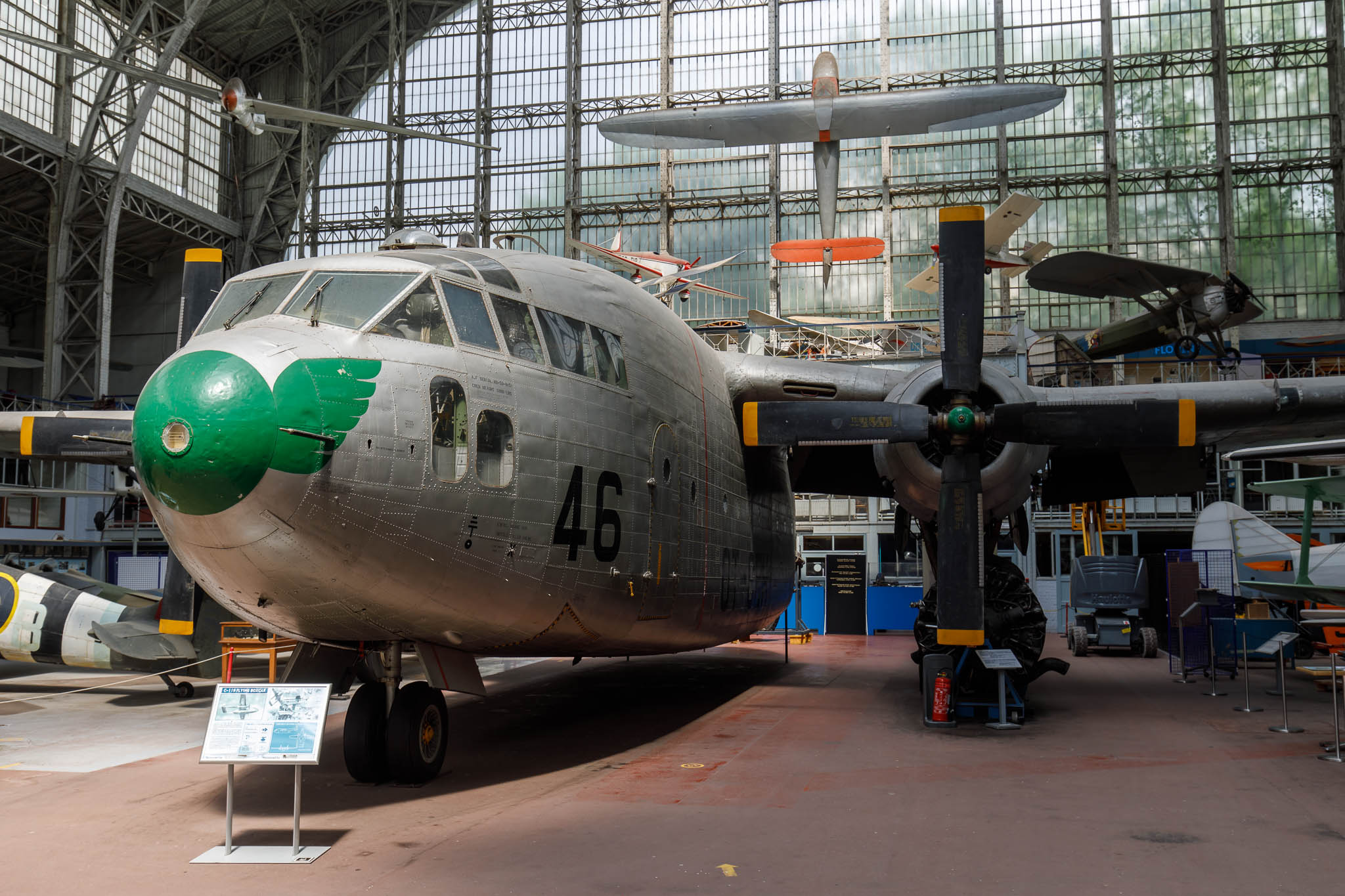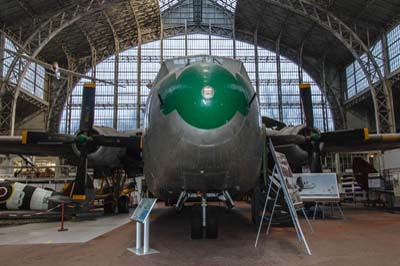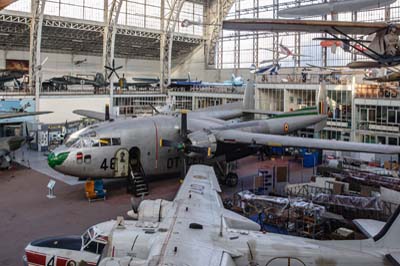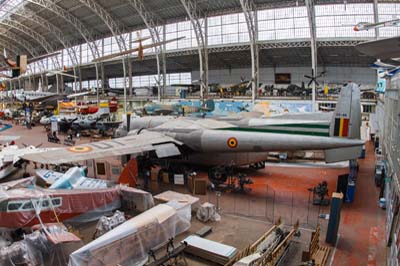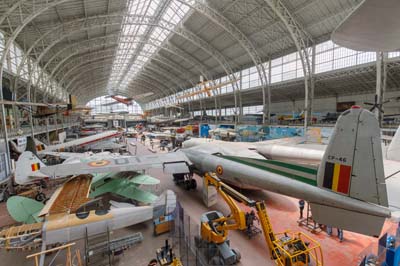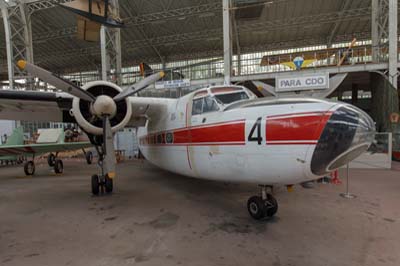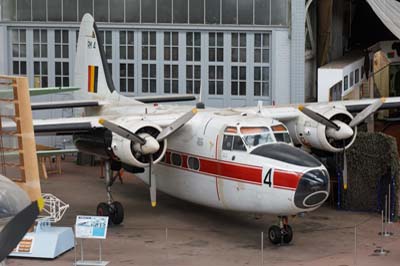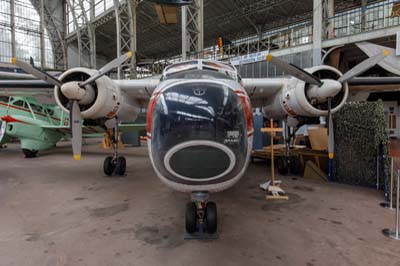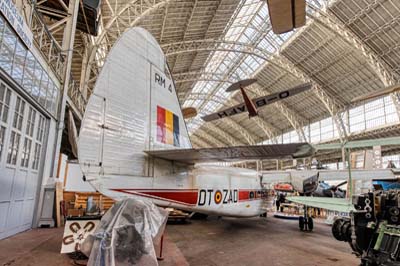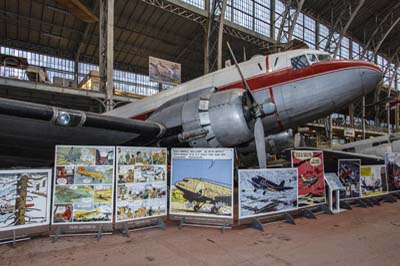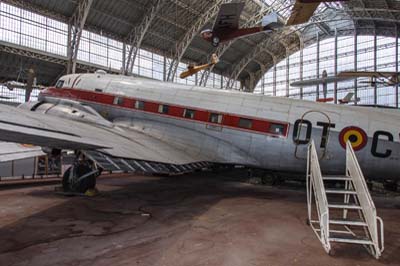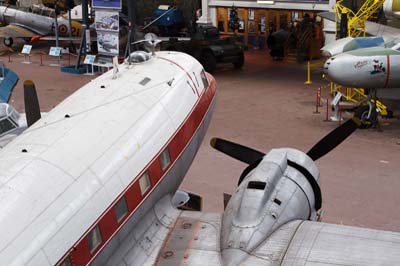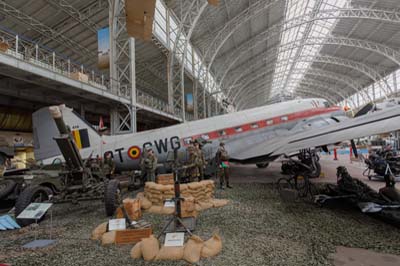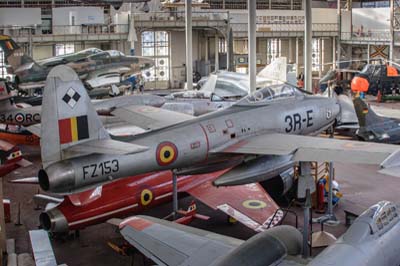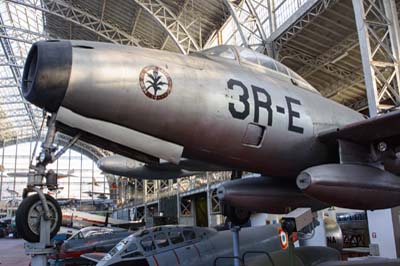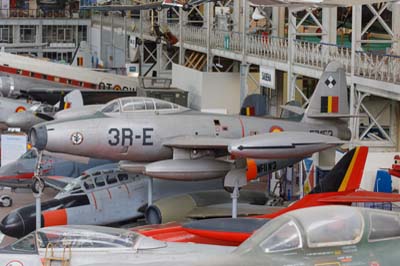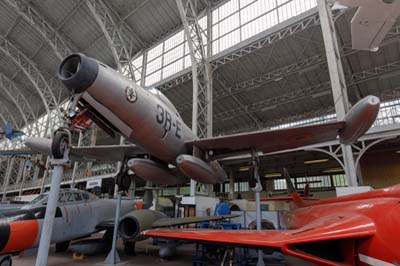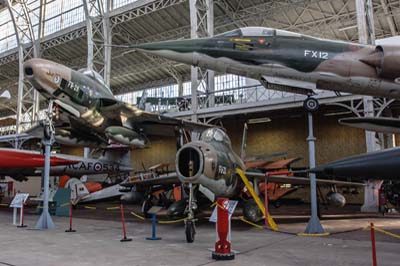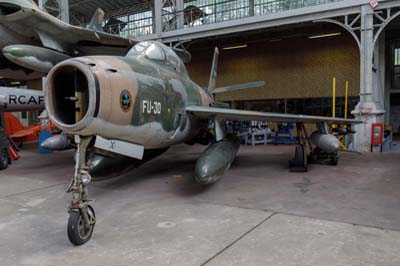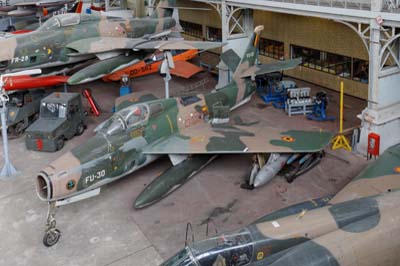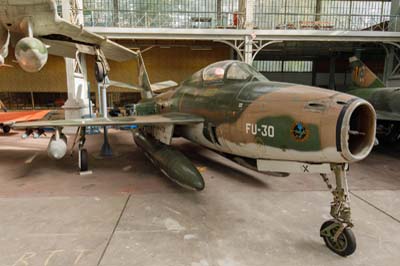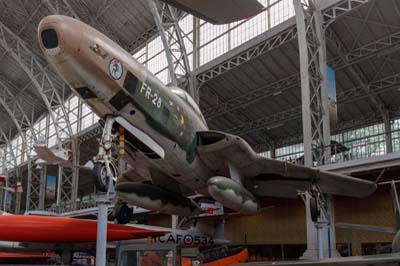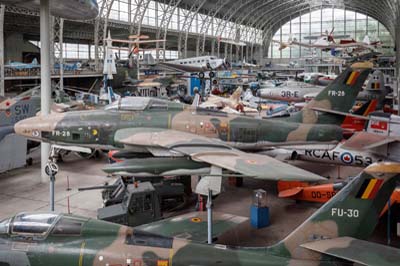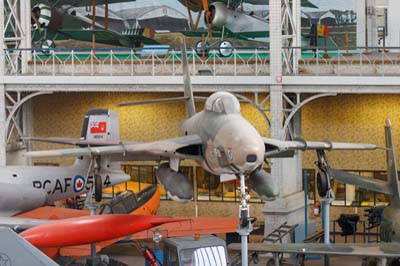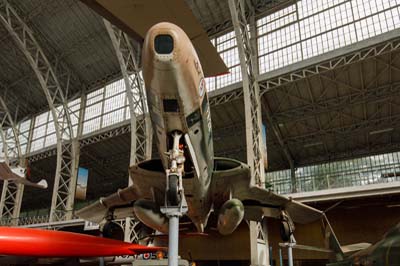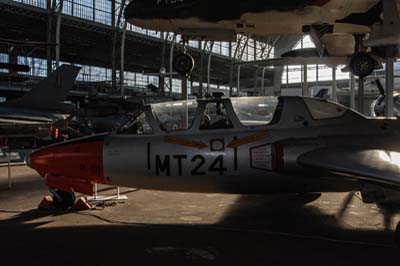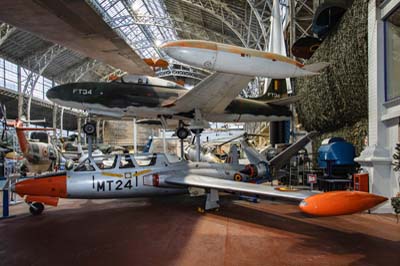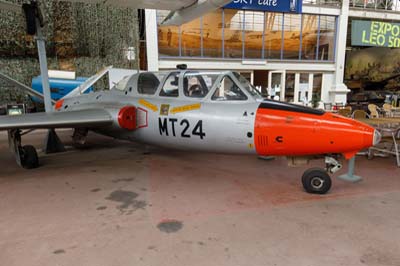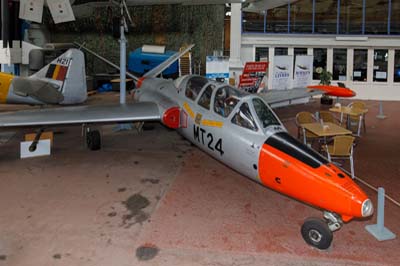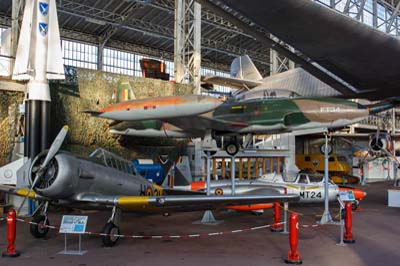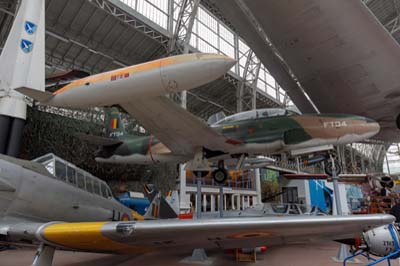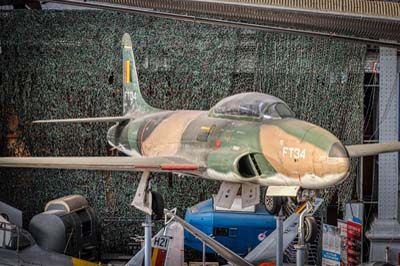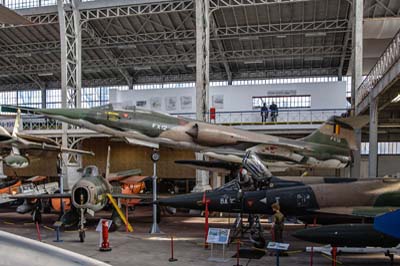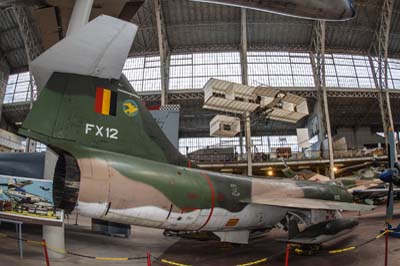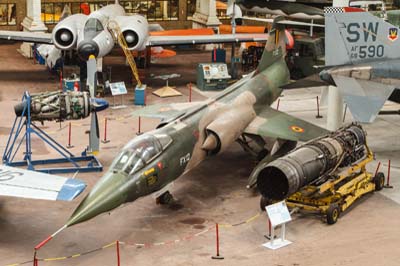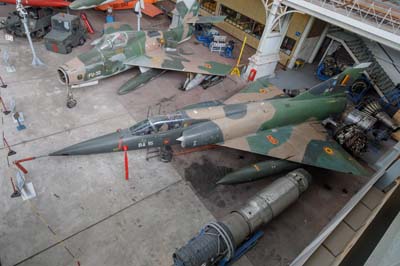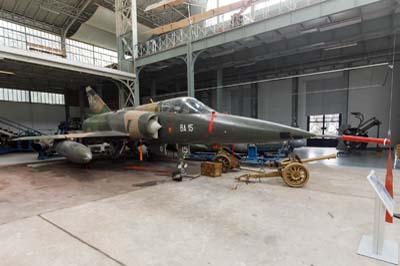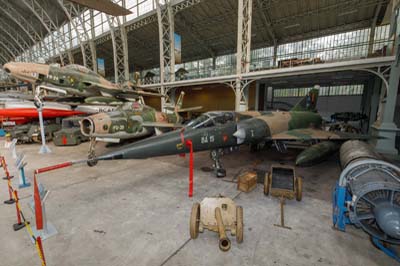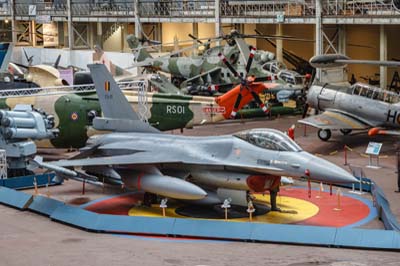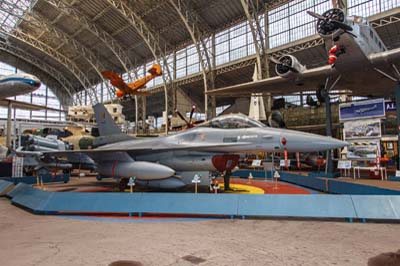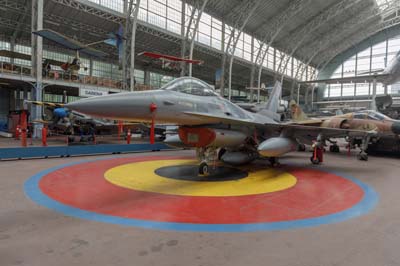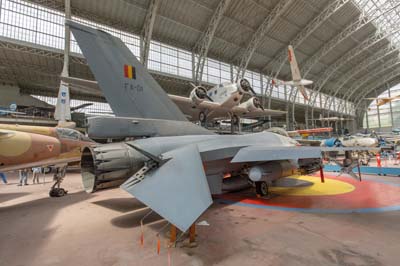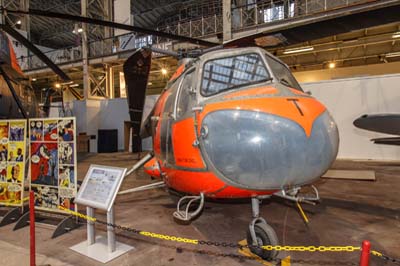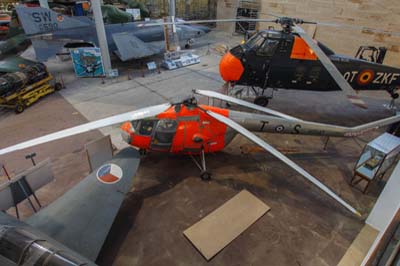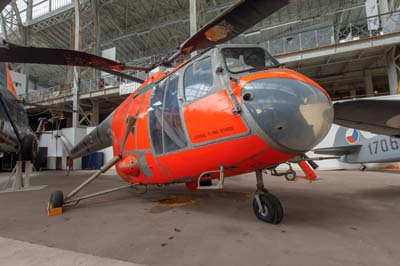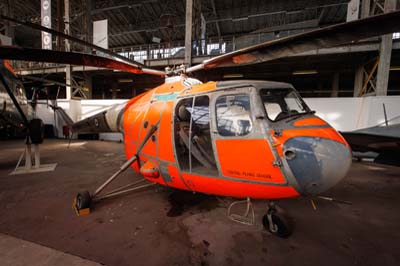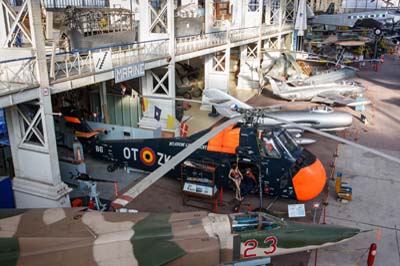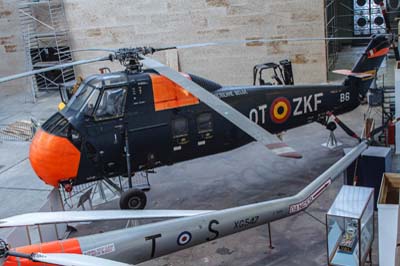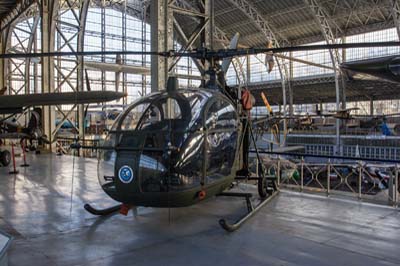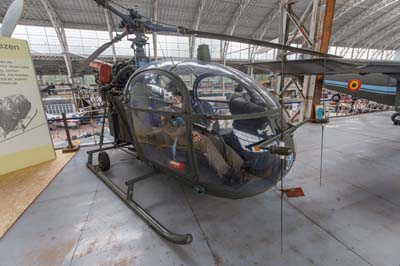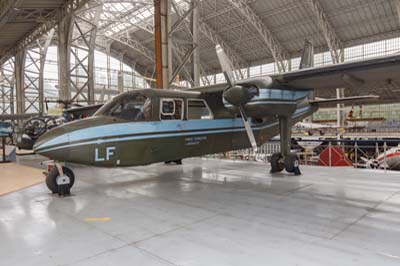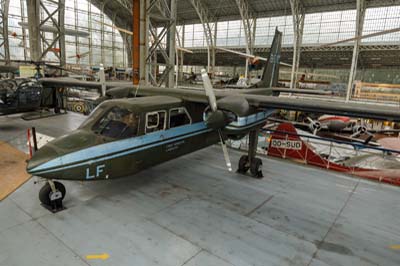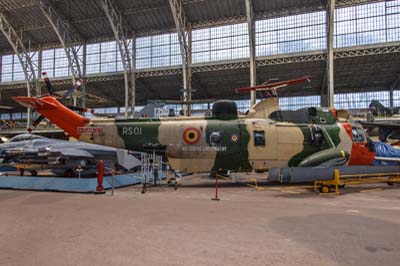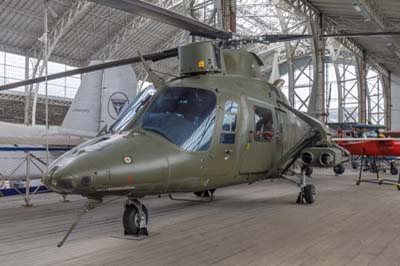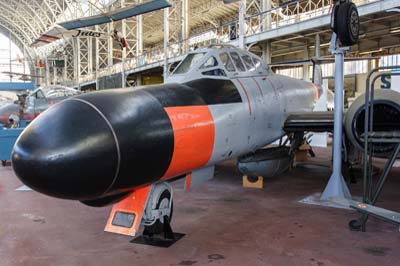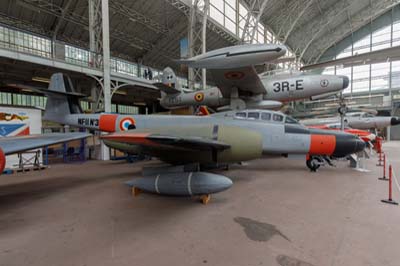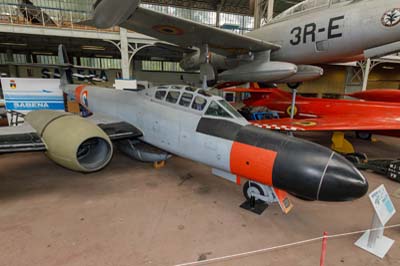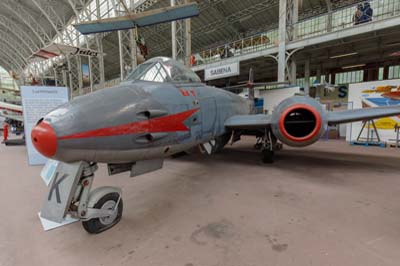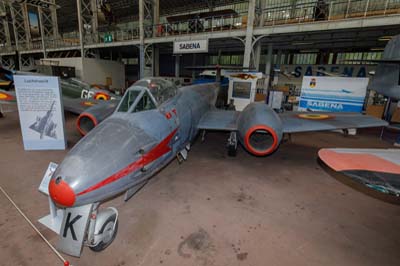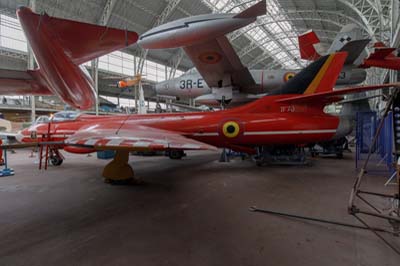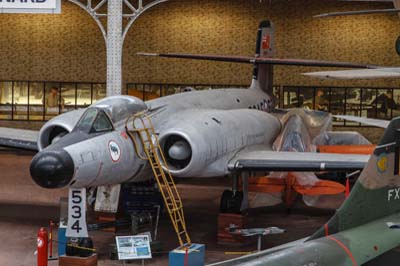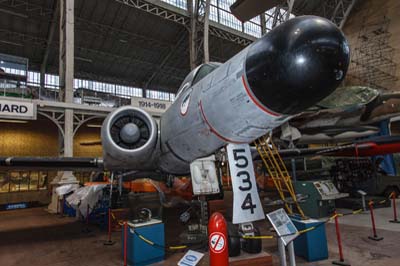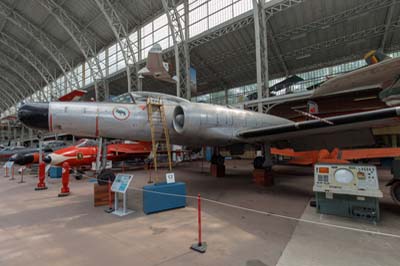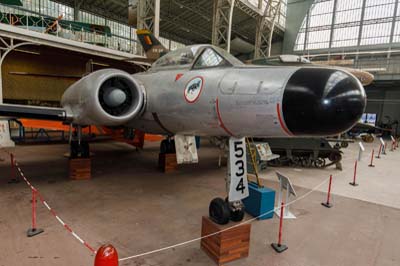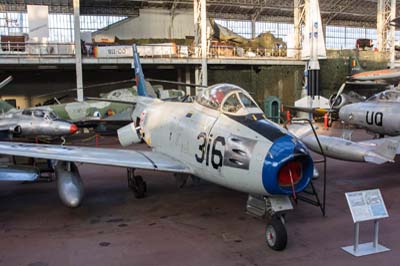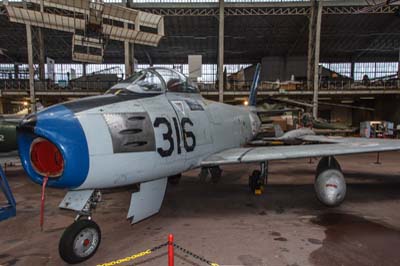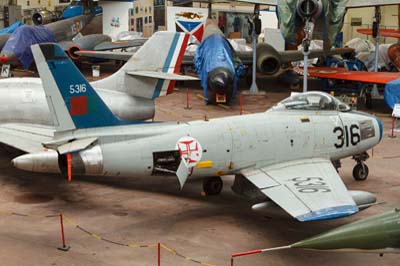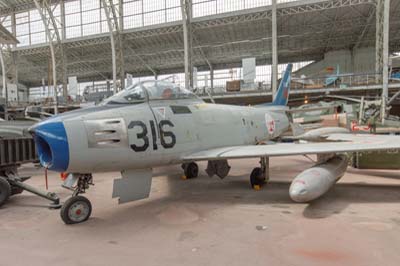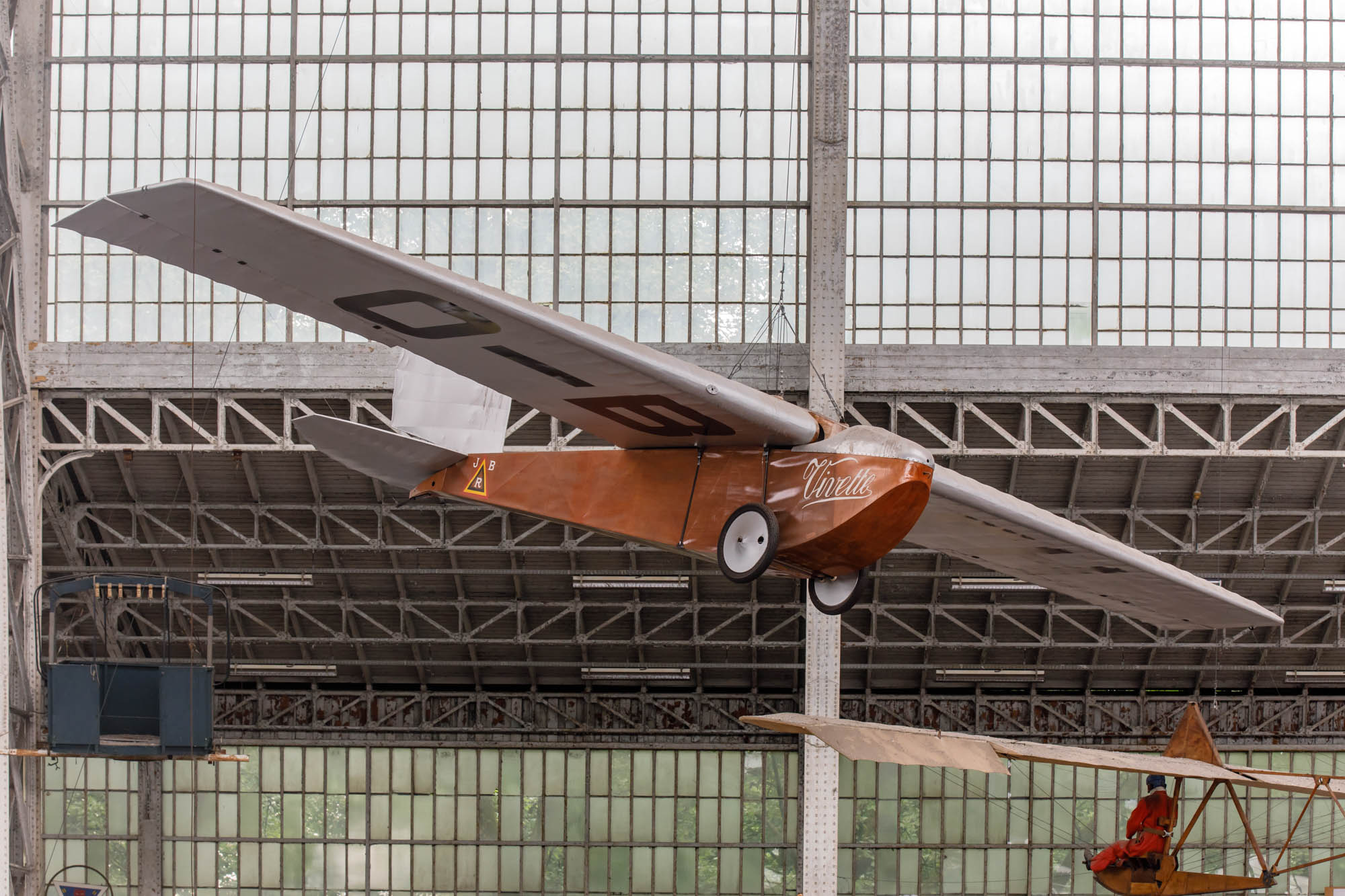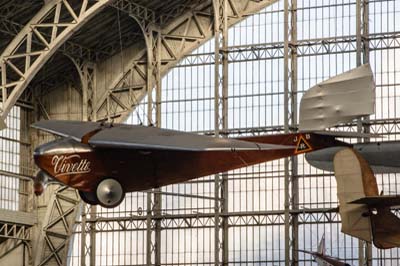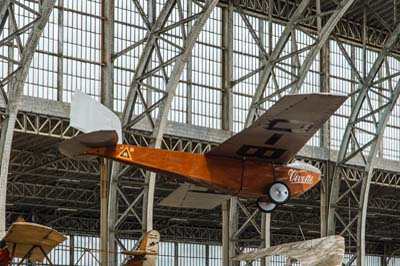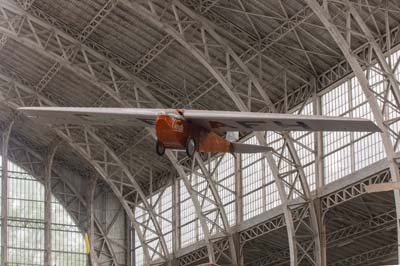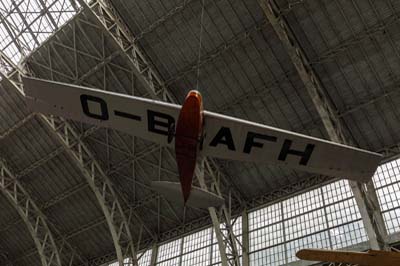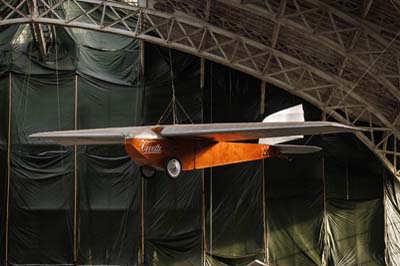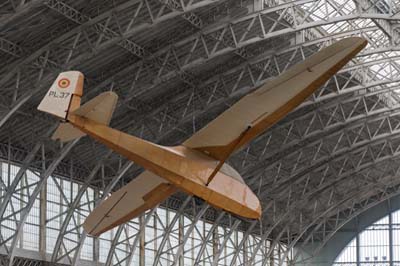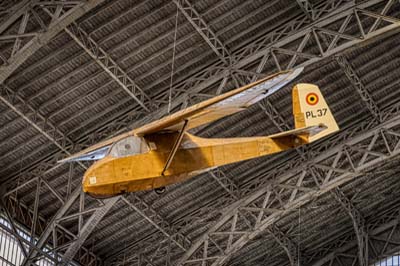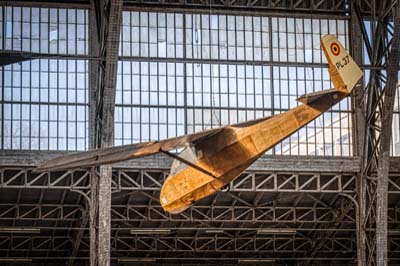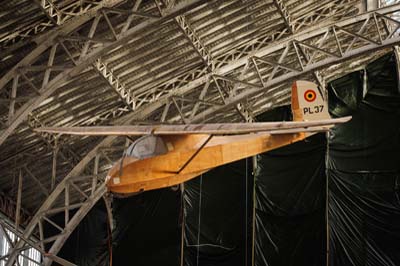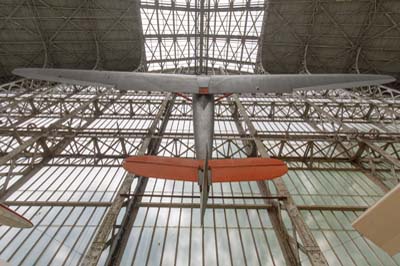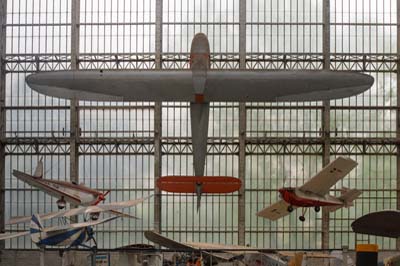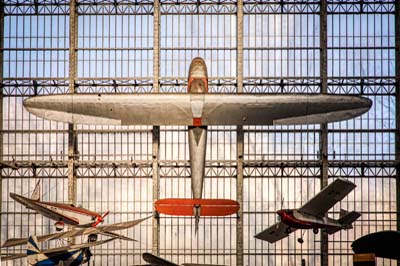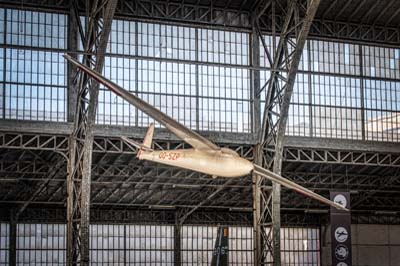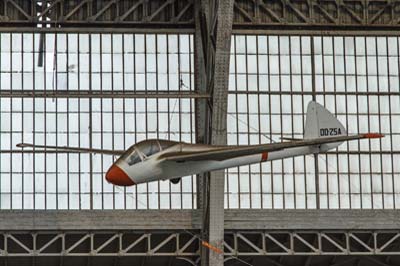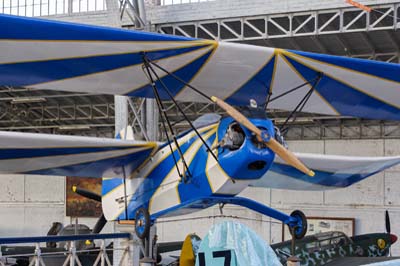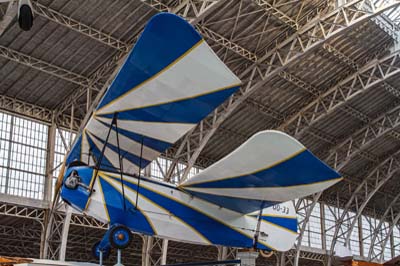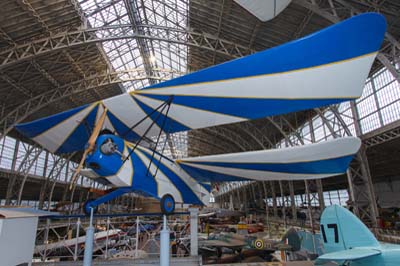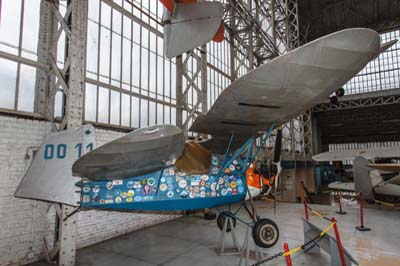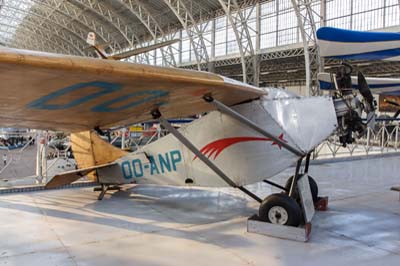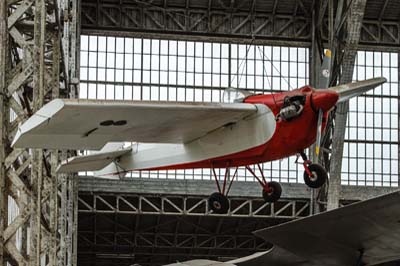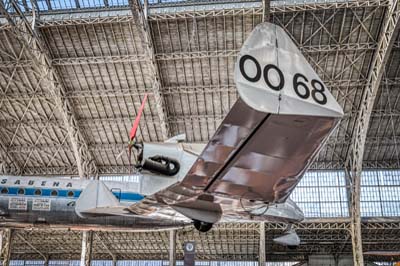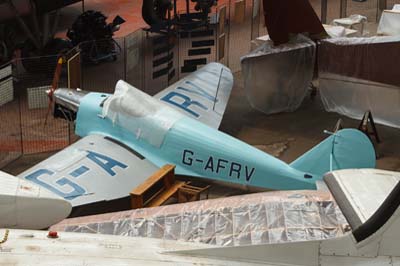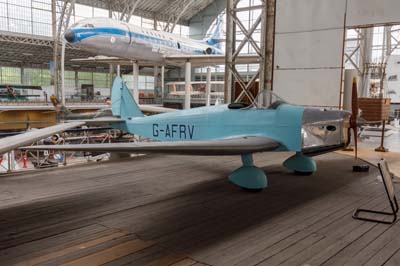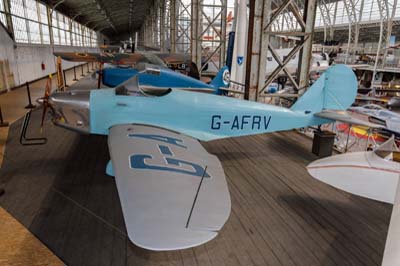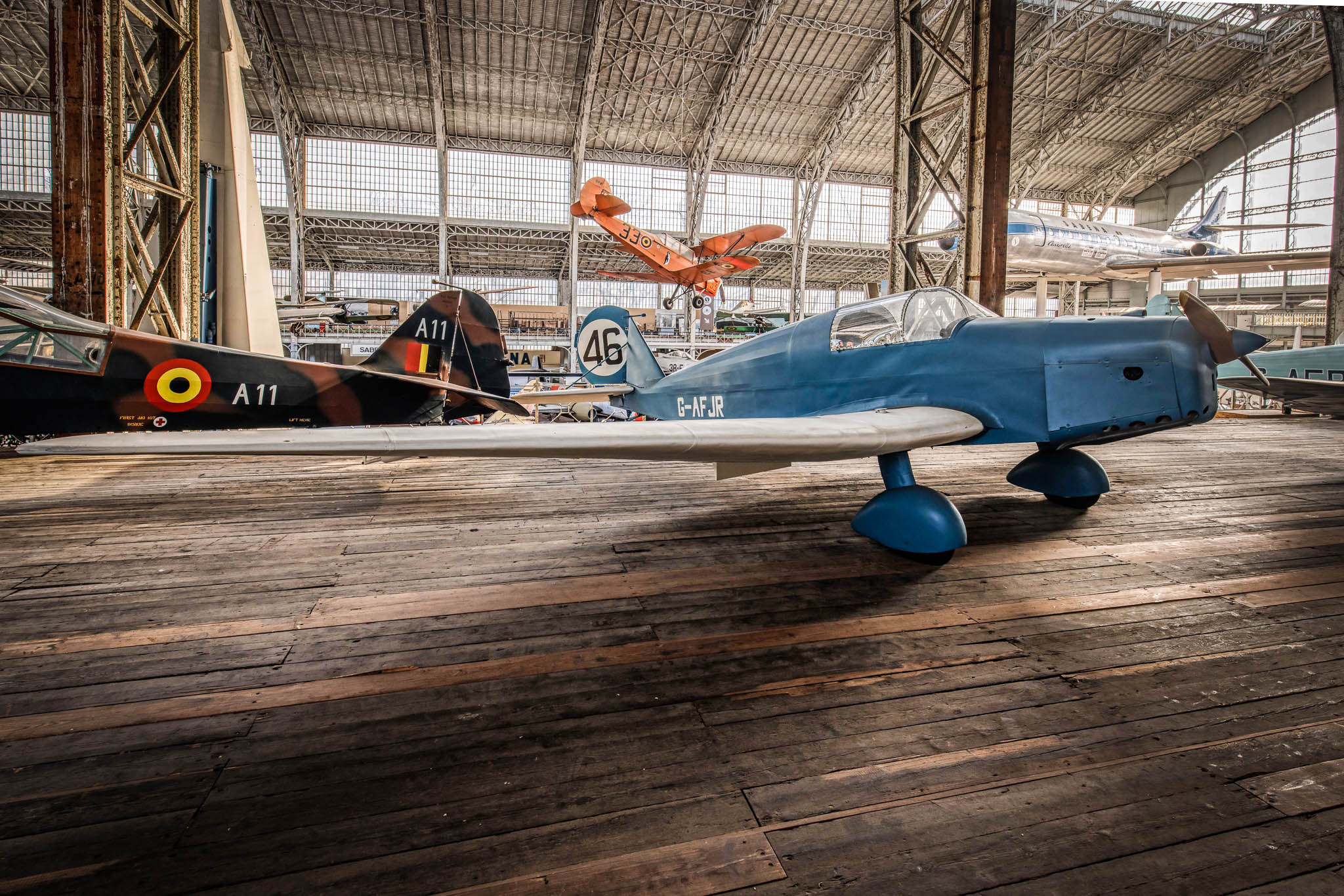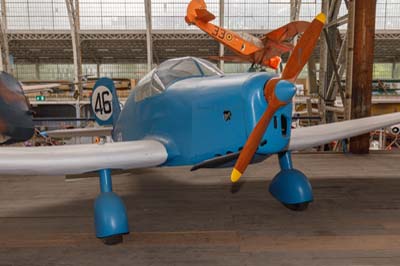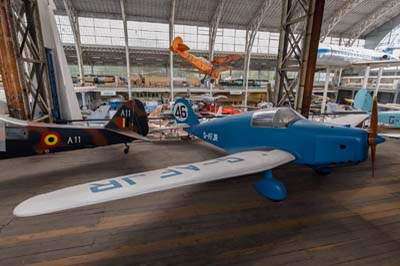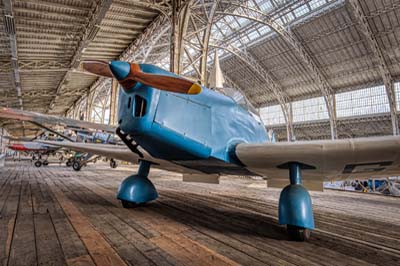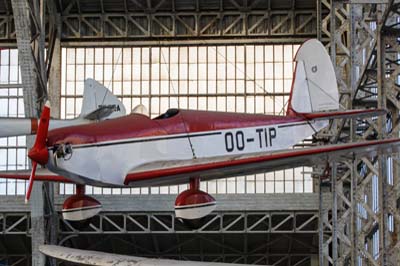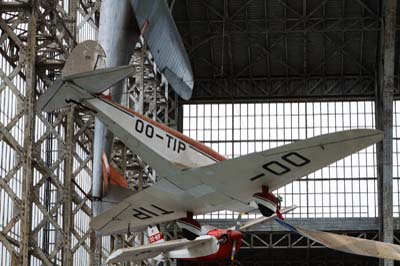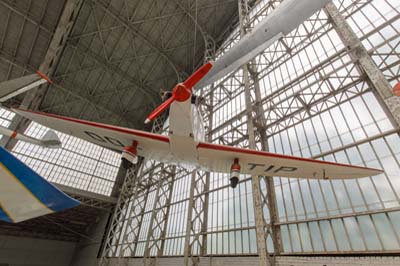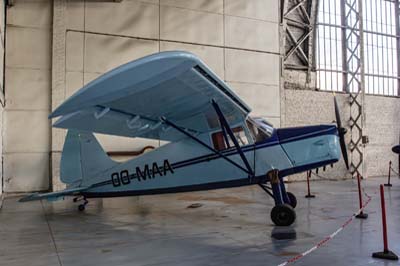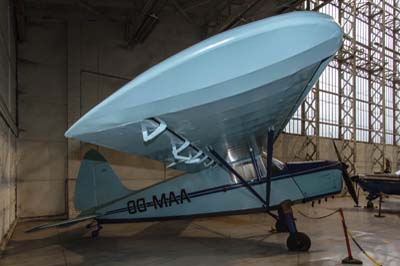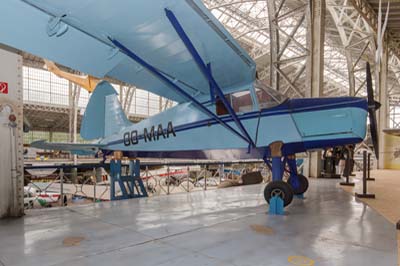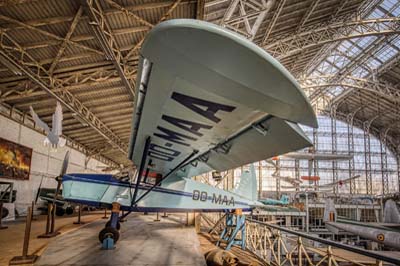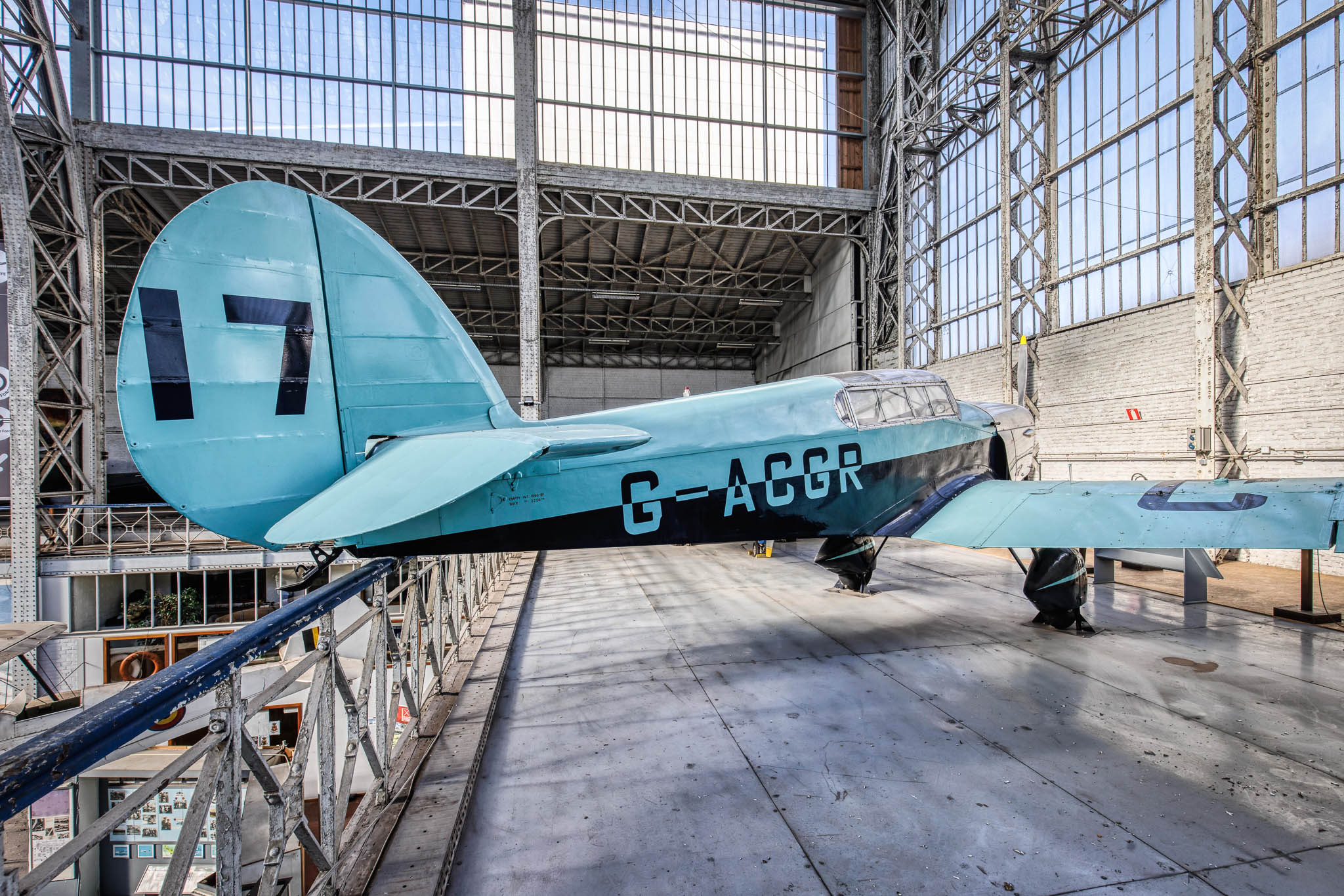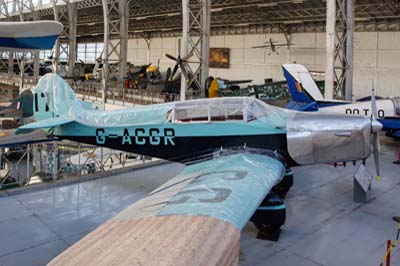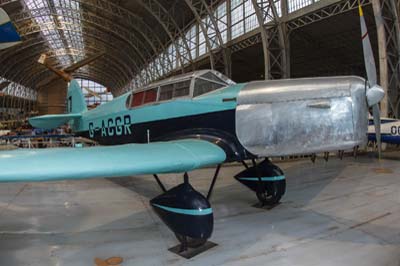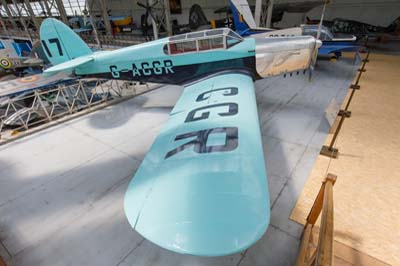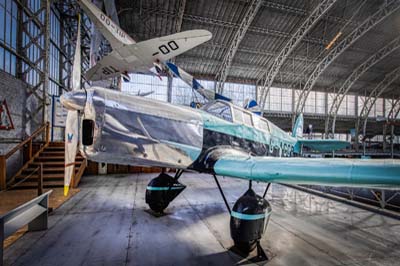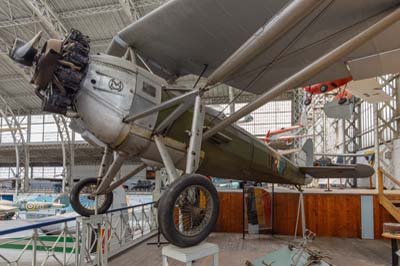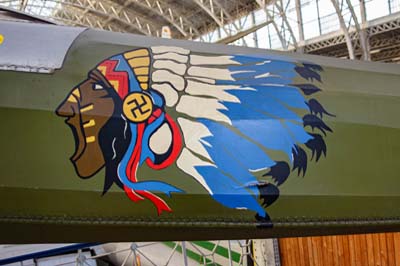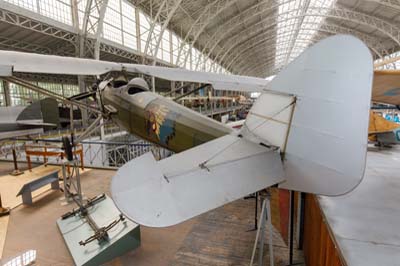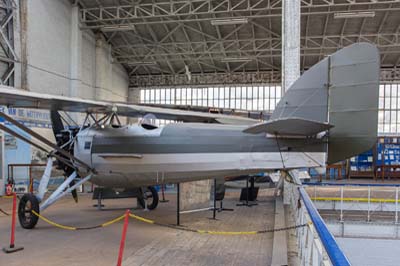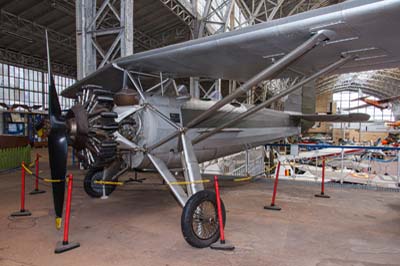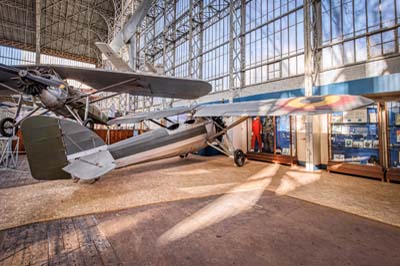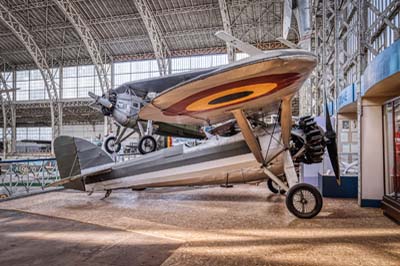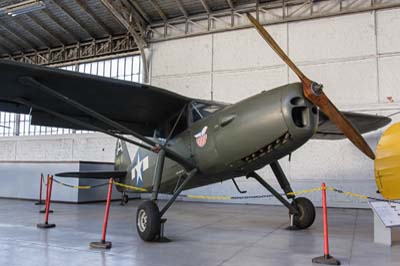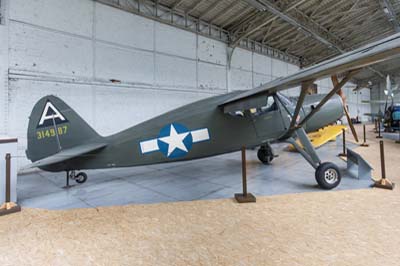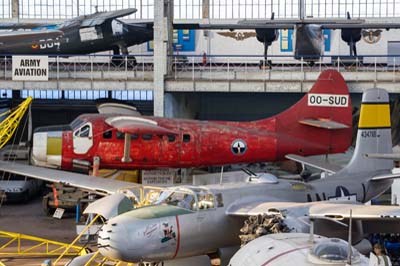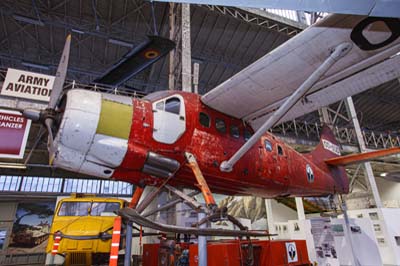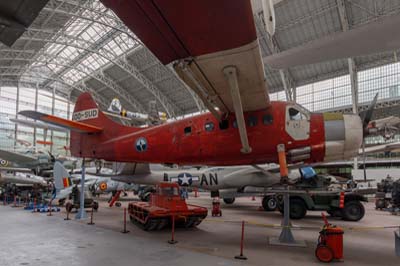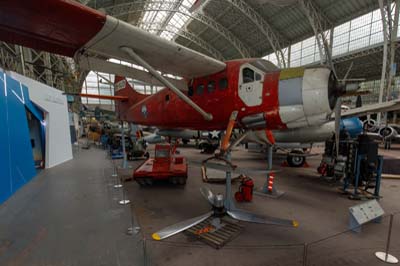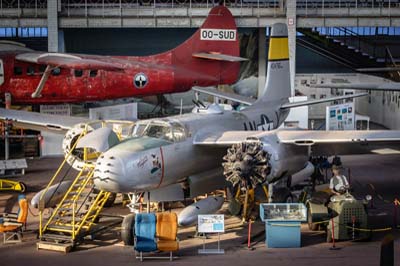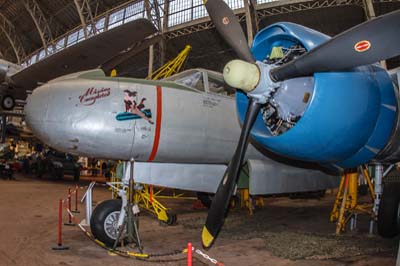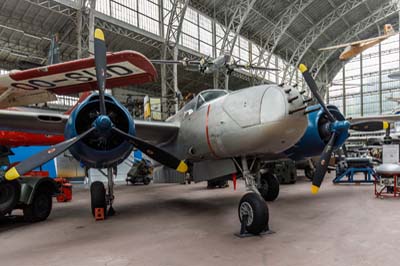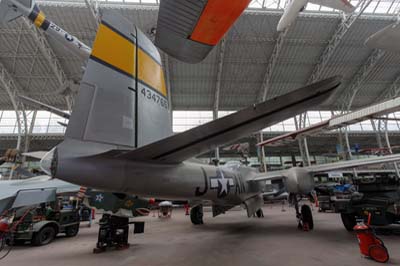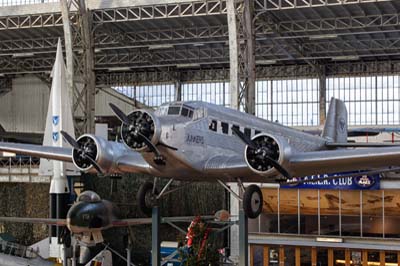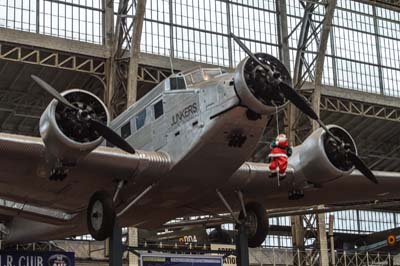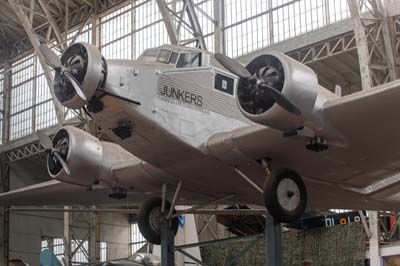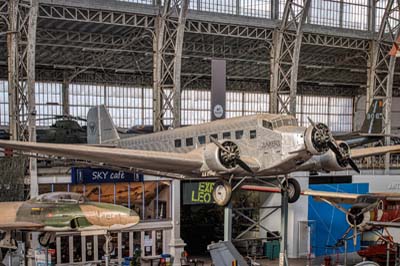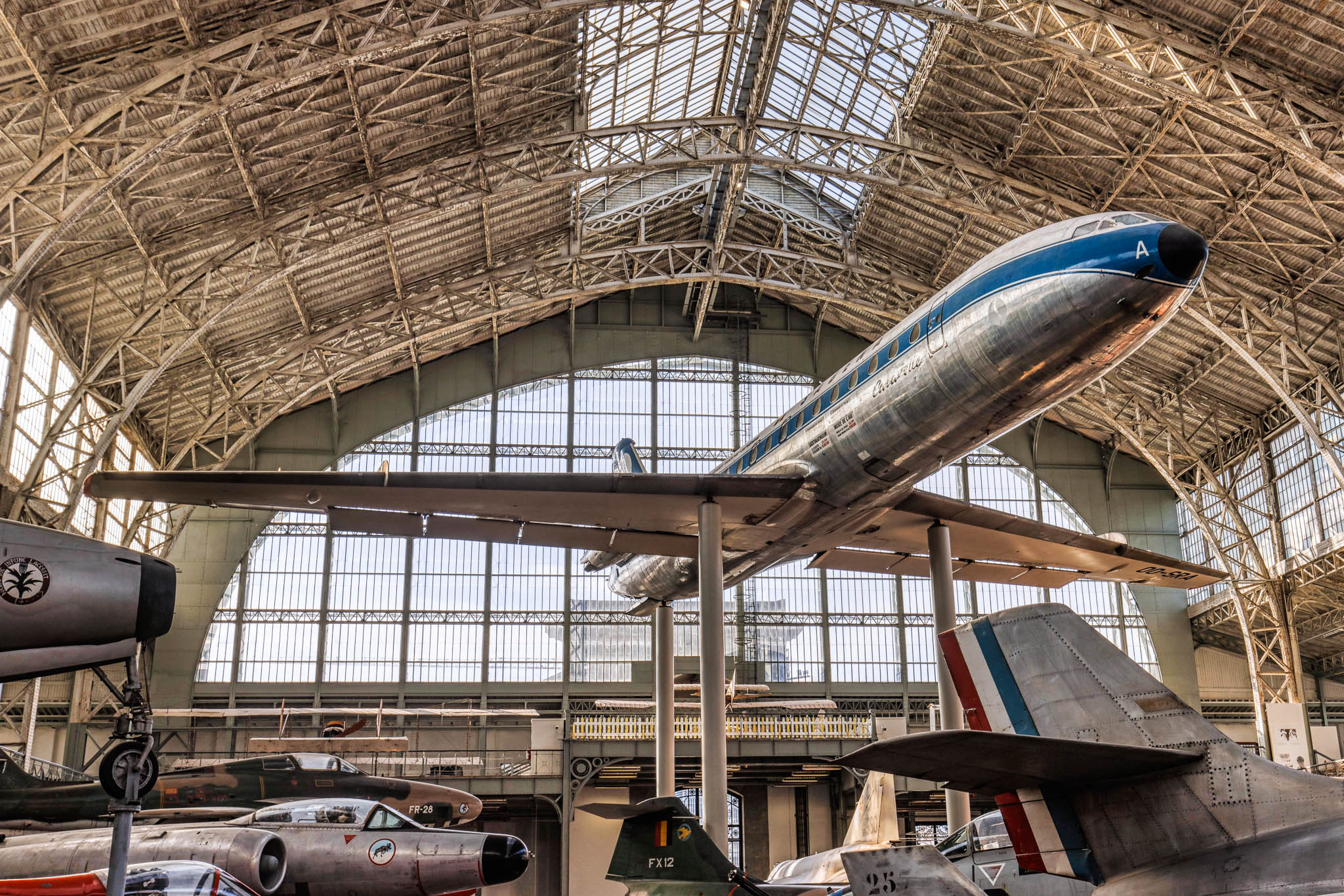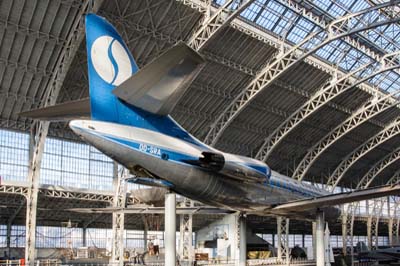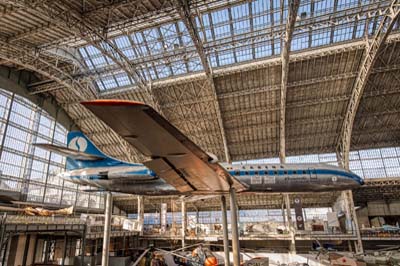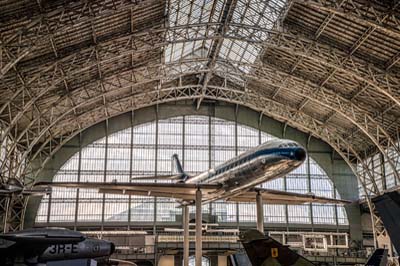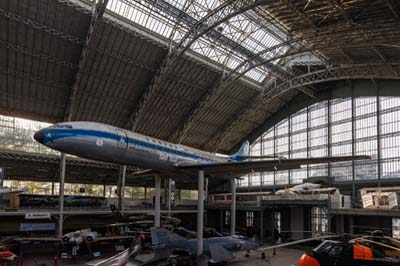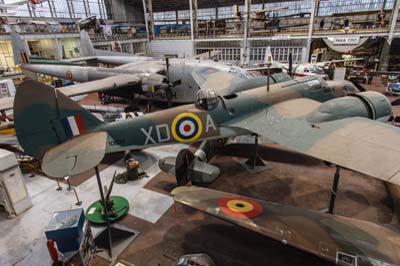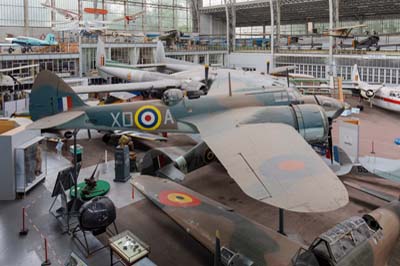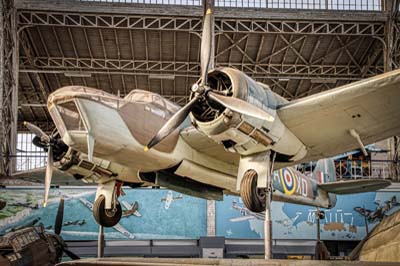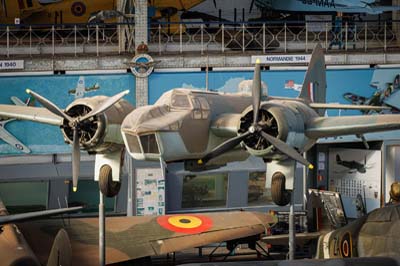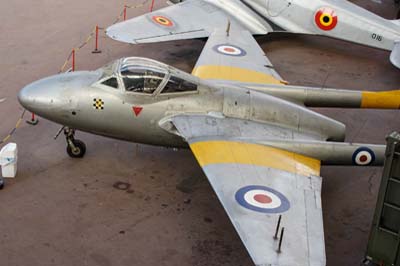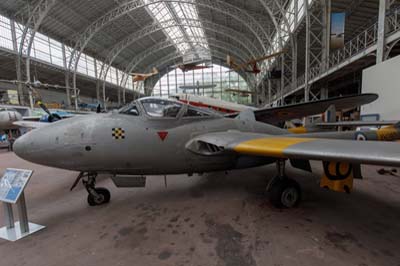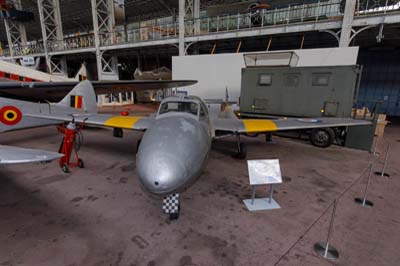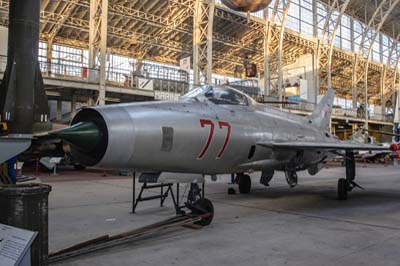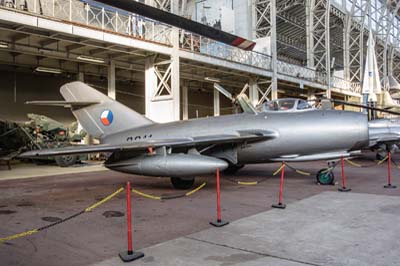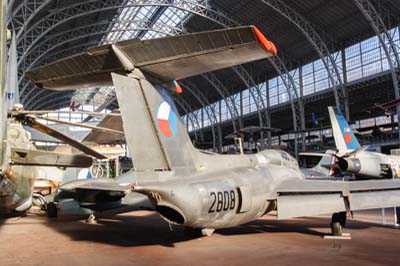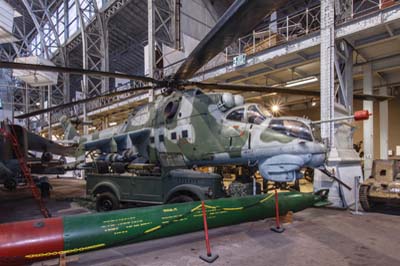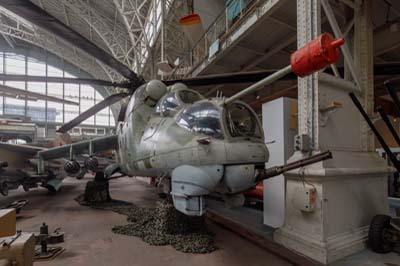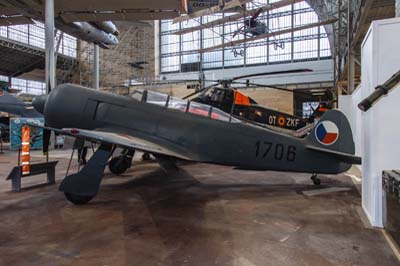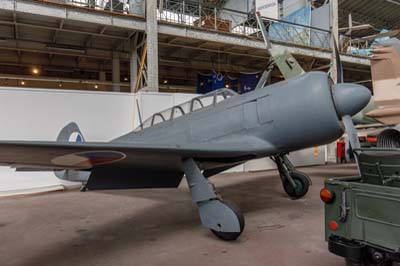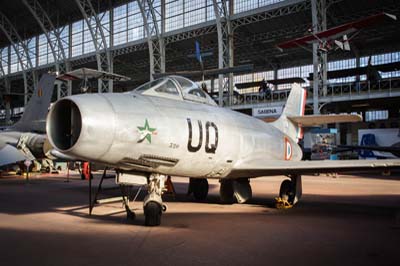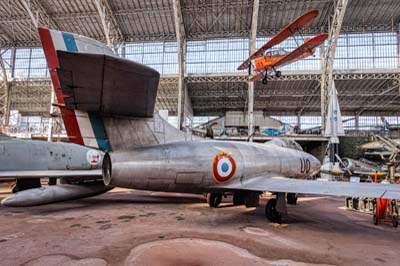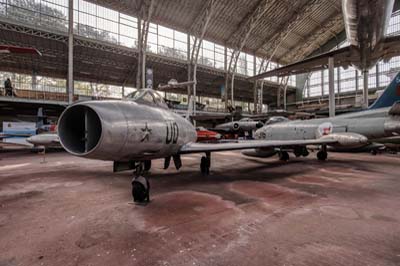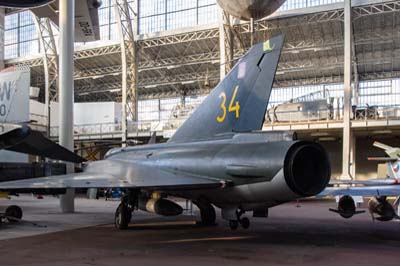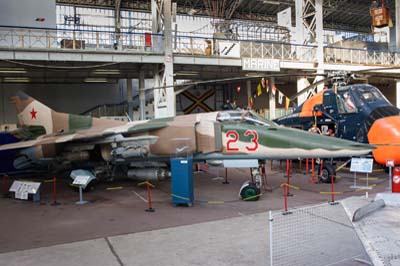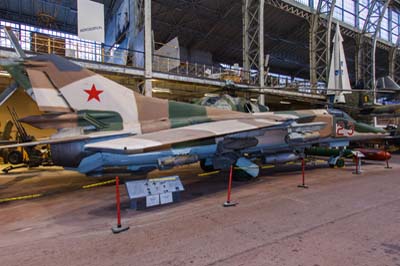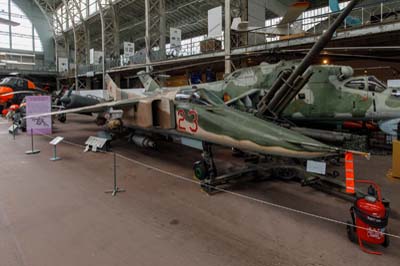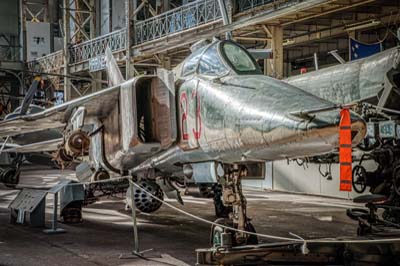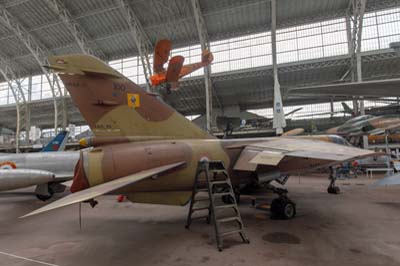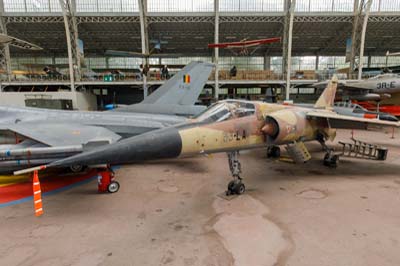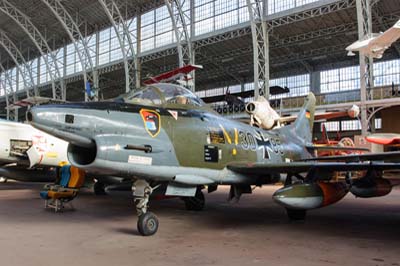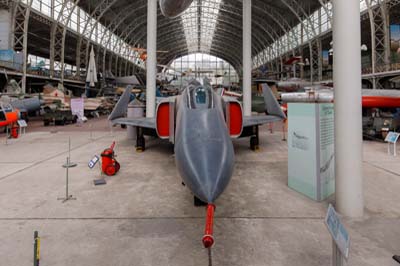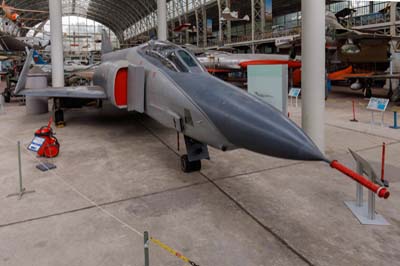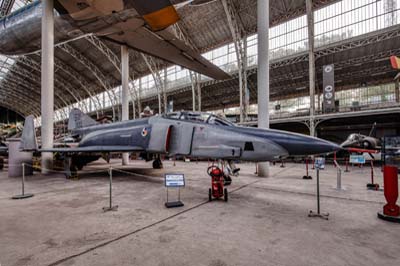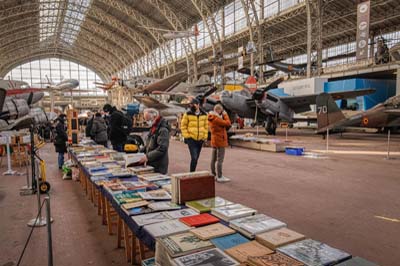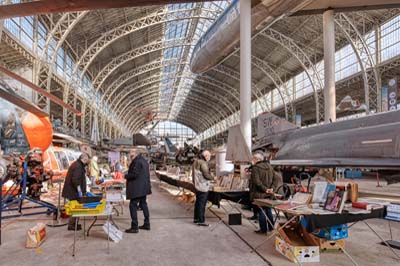Royal Museum of the Armed Forces and of Military History
(Air and Space Department)
(Musée Royal de l'Armée et d'Histoire Militaire, Bruxelles)
Brussels
2005, 2009, 2018, 2019, 2022 and 2024 |
| Fairchild C-119G Flying Boxcar (CP-46 'OT-CEH' of Belgian Air Force ex 53-8151). |
Fairchild C-119G Flying Boxcar (CP-46 'OT-CEH' of Belgian Air Force ex 53-8151). The C-119 followed on from the C-82 Packet built by Fairchild between 1945 and 1948. The C-119 made it's first flight in 1947 and by 1955, when production ended, 1184 had been built. The USAF used the C-119 as a transport and as a gunship during the Korean and Vietnam wars. The first batch of 18 C-119Fs (serials CP-1 to CP-18) for the Belgium Air Force were delivered between 1952 and 1956. A second batch of 38 C-119Gs (serials CP-9 to CP-46) were delivered from 1953 to 1958. The Flying Boxcar continued in service with the Belgium Air Force till their eventual retirement in 1972. The example on display (CP-46 'OT-CEH') built by Kaiser, a Fairchild subcontractor and was the last Belgian aircraft to be delivered. Ending it's service with 20 Squadron of the 15th Wing at Brussels-Melsbroek, many of the remaining fleet weren't quite so lucky and were scrapped at Koksijde during 1973.
The elevated angle reveals what is currently being worked on in the restoration and assembly area. |
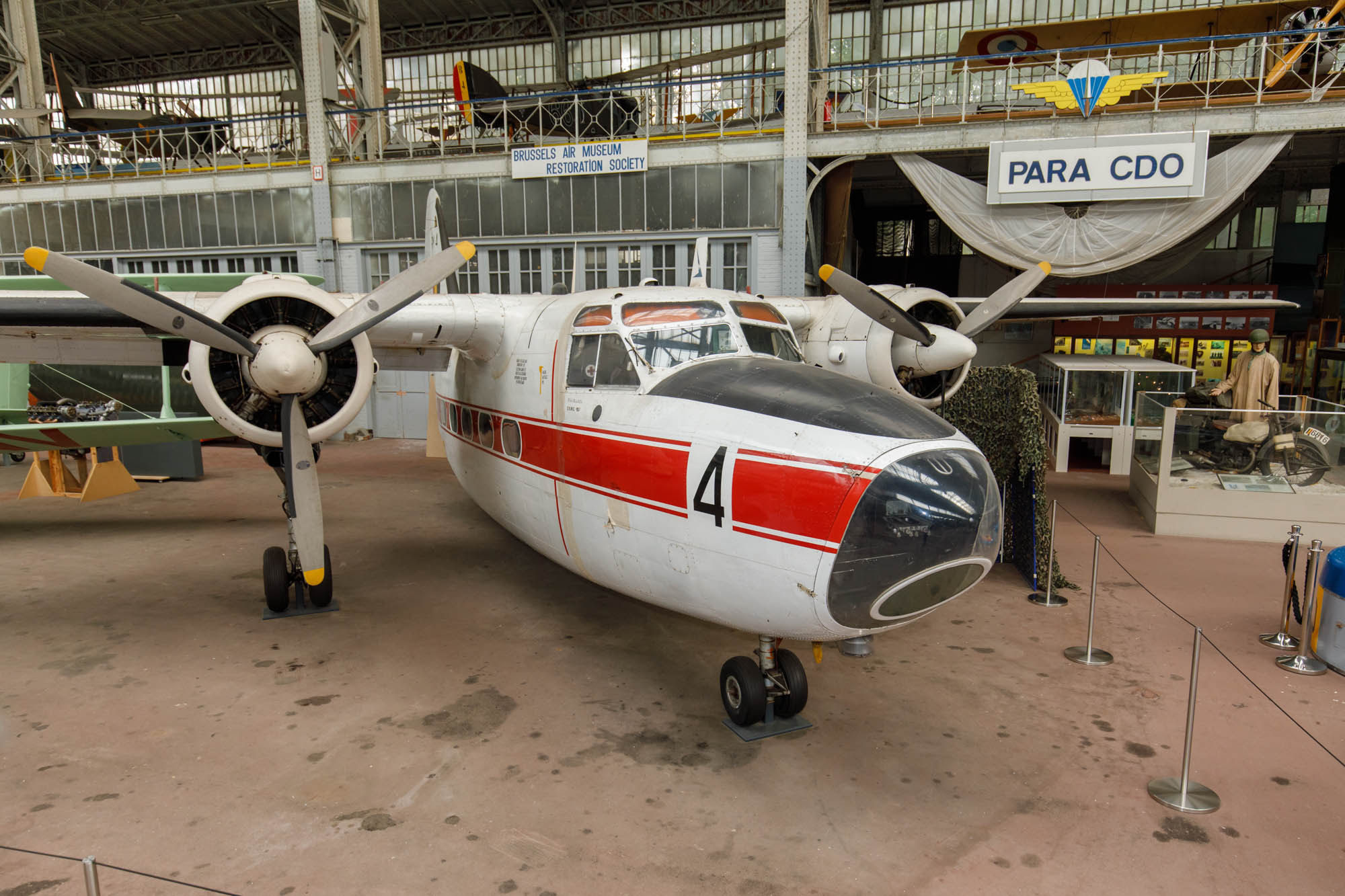 |
| Percival P.66 Pembroke C.51 (RM-4 'OT-ZAD'). The Pembroke entered service with the Royal Air Force as the Percival Pembroke C.1 in 1953 to replace the Avro Anson for light transport duties. Belgian Air Force operated 12 C.51s from 1954 to 1976. As photographed in; 1982 and 1995 |
| Douglas C-47 Dakota (K16 'OT-CWG' of Belgian Air Force c/n 20823 ex 43-16357 USAAF). Delivered to the Belgian Air Force in 1947 as K16 for 366 Squadron, it was later converted to be a VIP transport before being damaged beyond economic repair in 1972 and transferred to the museum the following year. |
| Republic F-84G Thunderjet (FZ-107 but painted as 'FZ-153 / 3R-E' previously 51-1066). The F-84E Thunderjet first flew in 1949 with 843 being built. 21 aircraft were delivered to the Belgian Air Force (serials FS-1 to FS-21) under funding from the Mutual Defence Aid Program (MDAP) from 1951, which was superseded by the Military Assistance Program (MAP) from the early 1960s. They remained in service until 1956. This was only the second jet to be operated by the Belgian Air Force, the first being the Meteor. The F-84G entered service in 1951, 3,025 were built with 1,936 being transferred to NATO countries in Europe. 213 F-84Gs (serials FZ-1 to FZ-213) were supplied to Belgium, starting in 1952. Before they were retired in 1957, 54 aircraft had been lost in accidents. The example on display (FZ-107 ex 51-10667) is marked as 'FZ-153' and is coded '3R-E' of 1 Squadron, 2 Wing (badge on tail) it was damaged beyond repair in 1954 and restored with tail of FZ-71. |
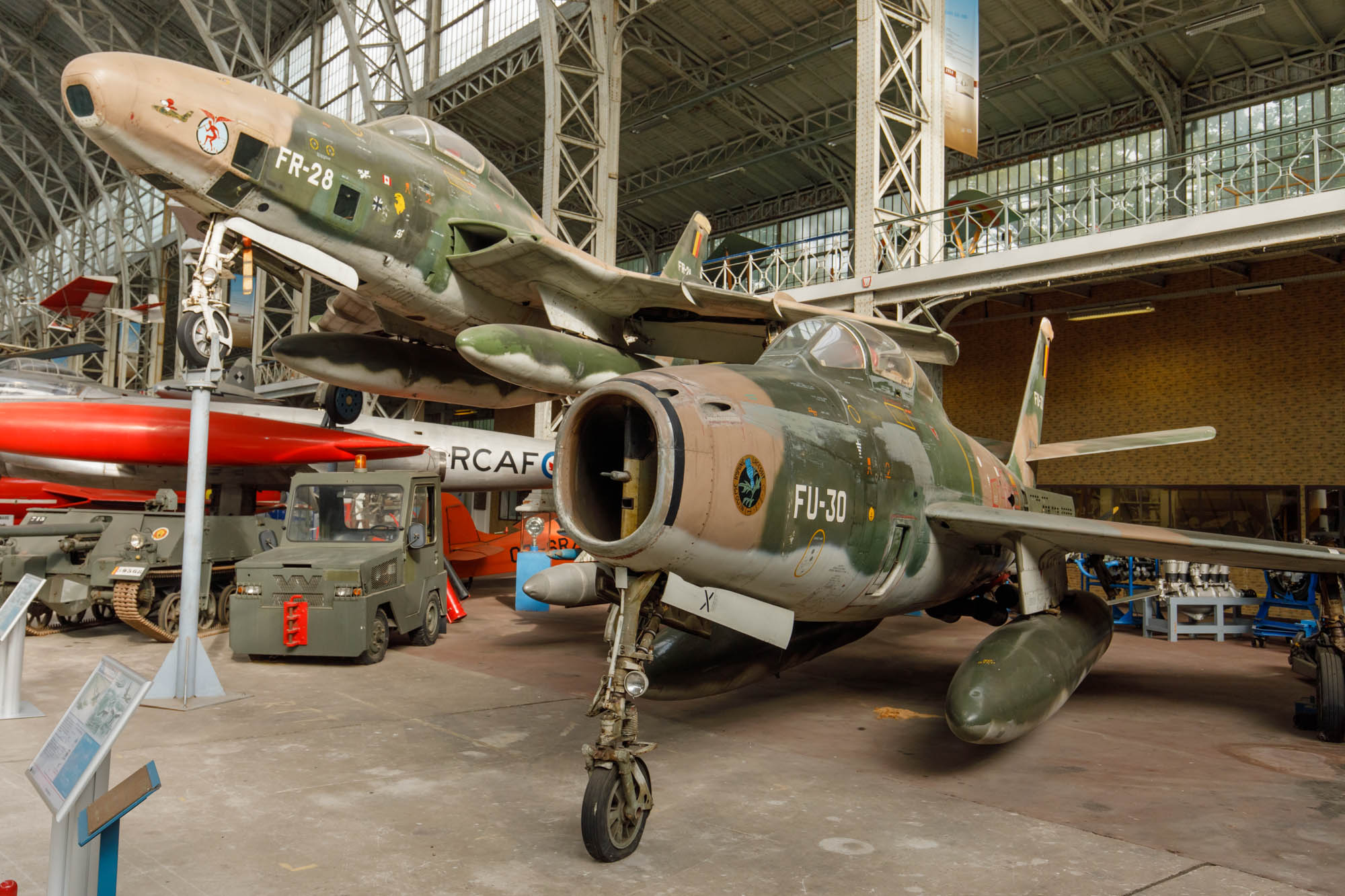 |
| Republic F-84F Thunderstreak (FU-30 ex 52-7169). The F-84F was developed after the F-84G and was a vastly different aircraft. It had 40 degree swept back wings, instead of the straight wings of the F-84G. It was originally designated the YF-96A and was capable of speeds of 695 m.p.h. The F-84F was supplied to NATO countries, of the 2,711 built 1,301 went to Europe. Belgium took delivery of 197 aircraft from 1955 (serials FU-1 to FU-197) to replace the F-84G. They remained in service until 1972. These in turn were replaced by the F-104G Starfighter starting from the 1960s. |
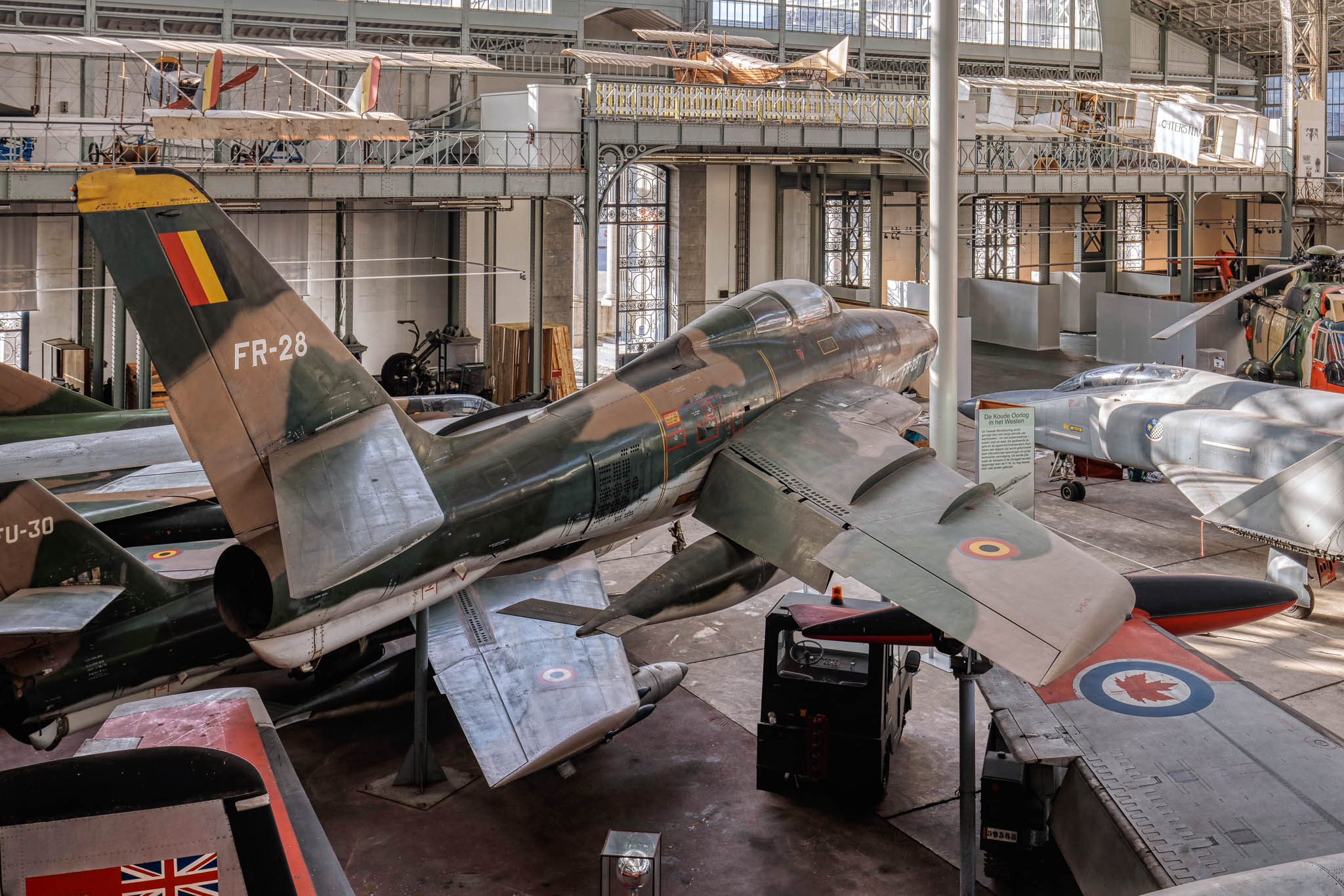 |
Republic RF-84F Thunderflash (FR-28 ex 51-1945). The RF-84F was the first jet aircraft to be designed solely for photo-reconnaissance, which could be achieved both day and night. The Belgian Air Force took delivery of 34 of these innovative aircraft (serials FR-1 to FR-34). They entered service in 1955, operating with 42 Squadron until there final retirement in 1972. The museum had up to nine F-84Fs and a RF-84F in storage for many years, but these are believed to have now been scrapped.
The F-84s flew in the silver colour scheme until 1967 when a Vietnam camouflage scheme was applied. |
| Fouga CM.170R Magister (MT-24 of Belgian Air Force). The CM.170R Magister was designed as a jet trainer to NATO specifications in the 1950s. It is fully aerobatic and served with the French 'Patrouille de France' and Belgian 'Red Devils' display teams for many years. The Belgium Air Force took delivery of 54 Potez-Fouga built Magisters from 1960 with another five refurbished (ex Luftwaffe) Messerschmitt built aircraft arriving between 1960 and 1962. They remained in service till 1998. The Magister serials were MT-1 to MT-50 with some serials being used twice following write-offs. The example on display (MT-24) was withdrawn after landing accident at Solenzara in November 1978, transferring to the Museum in 1979. As photographed in 1982. |
| Lockheed T-33A Shooting Star (FT-34 ex 55-3043). The T-33A was based on the single seat P-80, first flying in 1948. From 1952 till 1956 the Belgian Air Force received 39 T-33As (serials FT-1 to FT-38), eight were later transferred to the Dutch Air Force. They were needed to train pilots on the new F-84s that were now being delivered. They remained in service until 1979 as jet trainers. As photographed in 1982. |
| Lockheed F-104G Starfighter (FX-12). The first F-104A Starfighter flew in 1954. Production of this multi-role, all-weather strike fighter was started in many of the countries which adopted this unique aircraft, such as Fokker in Holland, Fiat in Italy, Messerschmitt in Germany and SABCA in Belgium. The two-seat TF-104G Starfighter's were manufactured by Lockheed. The F-104G had a maximum speed of 1,328 m.p.h. at 35,000 feet and could climb to 90,000 feet. The Belgian Air Force were supplied 101 F-104Gs (serials FX-1 to FX-100). An extra one was required to replace FX-27, which crashed during testing. They were delivered between 1963 and 1965. 12 TF-104Gs (serials FC-01 to FC-12) were delivered in 1965. The Starfighter was notoriously difficult to fly in some situations. The Belgian Air Force lost 41 F-104Gs and three TF-104Gs before their retirement in 1983. The Starfighter was replaced by the F-16A. The aircraft on display (FX-12) arrived at the museum in 1983. |
| Dassault Mirage 5BA (BA-15). The Mirage 5 is based on the Mirage 3, but having simplified avionics. 106 Mirage 5s were delivered to Belgium, comprising of; 63 BA 'strike', 16 BD 'two seat' and 27 BR 'reconnaissance' variants. Most of them were license built by SABCA/Avions Fairey at Gosselies and were produced from 1970. The aircraft exhibited (BA-15) has the tail badge of 8 Squadron (silver cygnet of folded paper on blue background). The Mirage 5 was withdrawn from service in 1994. |
| General Dynamics F-16A Fighting Falcon (FA-01). The YF-16 first flew in 1974, entering service a year later. To date over 4,400 F-16s have been delivered to at least 23 countries, with production in Europe in both Holland and Belgium. SABCA initially received an order to build 96 single seat F-16As, which was increased in 1983 to 136 (serials FA-01 to FA-136) and 20 (increased to 24) two-seat F-16Bs (serials FB-01 to FB-24). The assembly line opened in 1978. The first F-16 a two-seat, was delivered in 1979, by 1981 the first squadron (349) was fully operational. The final aircraft was delivered in 1985. The example on display (FA-01), had a period of storage with another 30 redundant F-16s, at Weelde from 1994. It was delivered from Weelde to the Museum in 1996. |
| Helicopters of the Belgian Air Force (Luchtmacht), Belgian Navy (Zeemacht) and Army (Landmacht). |
Bristol 171 Sycamore HR.14 (XG547 'S-T' later G-HAPR). The Sycamore was the first British helcopter to serve with the RAF, it first flew in 1947. 88 HR.14s were built, 85 of which served with the RAF and three HR.14s were delivered to the Belgian Air Force for operations in the Belgian Congo.
XG547 had previously been on display at The Helicopter Museum (THM) at Weston-Super-Mare from 1988 to 2008, following its repaint at Yeovilton in 2003. It was exchanged in 2008 for a former Belgian Army Alouette II which is now on display at THM. |
Left to right:
Sikorsky UH-34G HSS-1 (B6 'OT-ZKF'). The Belgian Navy (Zeemacht) ordered eight Sud-Aviation HSS-1 Seabat (serials B-1 to B-8) in 1961 to fulfil a Search and Rescue (SAR) role in 1961. Later the Air Force bought from SABENA, seven S-58C (B-9 to B-15) for short range transport duties. They remained in service till 1986, some having been already replaced by the Sea King in 1976 and 1977. The S-58C on display (B-13 'OT-ZKM') arrived at the Museum on August 20, 1981.
Aerospatiale (Sud Aviation) Alouette II (A-11 c/n 1535). The Alouette first flew in 1955, it was the first Gas turbine powered helicopter, by 1975 1500 had been built. The Belgian Air Force (Landmacht/Force Aerienne) starting receiving them in 1959 (serials A-1 to A-81). Later a further six were received for the Police (Rijkswacht/Gendarmerie) (serials A-90 to A-95) in 1967. 90 Alouette II were delivered, again some serials were used twice. They were finally withdrawn from service in 1999. |
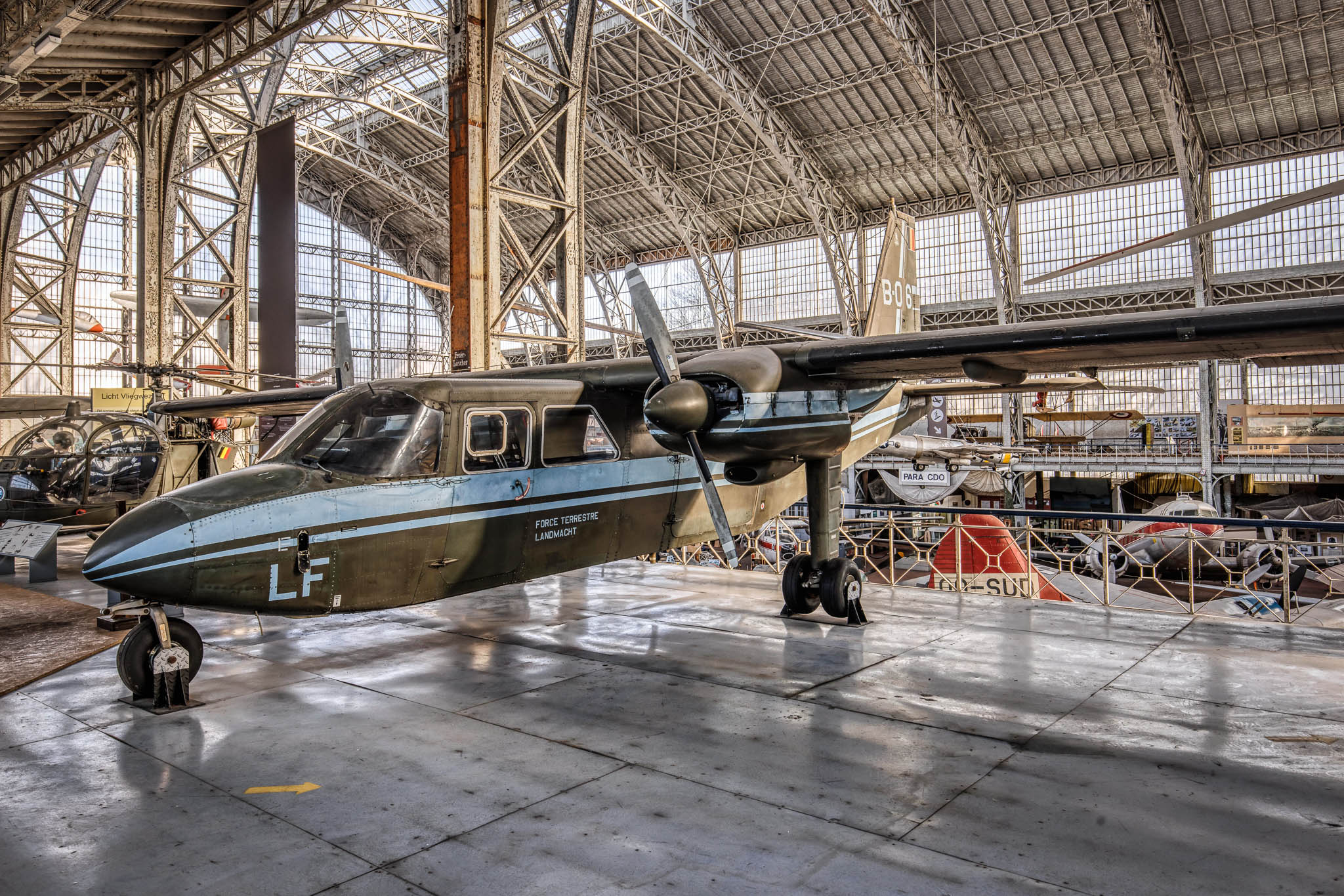 |
Left to right:
Britten-Norman (Fairey) BN-2A Defender (B-06 OT-ALF) The prototype Islander flew in 1965, with a military version called the Defender being launched in 1970. Fairey at their factory at Gosselies, Belgium started building the Islander from 1973. The Belgian Army received 12 Defenders (B-01 to B-12) from 1976. Following their retirement from service in December 2004, the seven remaining Defenders (including one wreck) were put up for sale in January 2006. B-11 is preserved at Brasschaat air base, B-02 and B-09 will be used by the Management Unit of the North Sea Mathematic Models for pollution control. The Museum's example (B-06 callsign 'OT-ALF' with 'LF' on nose) was withdrawn from service after hangar fire at Butzweilerhof and transferred to the museum in November 1988.
Westland Mk.48 Sea King (RS01) In December 2008 the first of five Sea Kings to be delivered to the Belgian Air Force (inscribed on aircraft 'Belgische Luchtmacht') was flown to the museum for permanent display. In poor weather the helicopter landed right in front of the museum at the end of its final flight from Koksijde where it operated with 40 Squadron (Smaldeel/Escadrille) on Search and Rescue duties. The helicopter has clocked 10,583 hours since it first flew in 1976.
Agusta A-109BA Hirundo 'Swallow' (H-08 OT-ARH). The A-109 first flew in 1971 and is a light-weight, twin engine, eight seat multi-purpose helicopter. In Belgian Army service the A-109s arrival was the subject of a bribing scandal. It was discovered that Belgian Socialists had received over 50 million francs for the purchase. Willy Claes, former NATO Secretary General was forced to resign and was later convicted. 46 A-109s were delivered (H-01 to H-46) from 1992 and most are still in operation. The example in the Museum (H-08) arrived September 7, 2005, having served with Belgian Army 'Light Aviation/Heli Wing' for eleven years before being withdrawn from service at Zutendaal in 2003. |
| Aircraft types that have served with the Belgian Air Force..... |
Left to right:
Gloster Meteor NF.11 (NF11-3). The Belgian Air Force flew four variants of Meteor. The first was the Meteor F.4, when 48 new Gloster built examples were delivered from June 1949. The F.4s were replaced by 240 F.8s from 1950 to 1954 this time built by Fokker. 24 of the F.4s were modified to a two-seat T.7 standard by Avions Fairey at Gosselies. The T.7s were retired in 1962, the F.8s followed into retirement a year later. Development of the NF.11 Night Fighter variant started in 1948, with 335 being built by Armstrong-Whitworth. In 1952 12 ex RAF Meteor NF.11s were delivered, with an additional 12 in 1956. By 1958 the Meteor had been fully withdrawn in favour of the new CF-100 Canuck. The Meteor NF.11 (NF11-3) on display did not actually fly with the Belgian Air Force, but was delivered to the French Air Force (Armée de l'Aire) in the 1950s. As photographed in 1995. |
Left to right:
Gloster Meteor F.8 (EG-224 'K5-K'). 240 Meteors saw Belgian service, EG-224 was from the first of a batch of 37 built by Gloster but assembled in Belgium by Fairey at Gosselies. They were in service from 1952 to September 1963.
Hawker Hunter F.4 (ID46 painted as 'IF70') in Red Devils display team colours. The Belgian Air Force received 112 Hunter F.4s between 1956 and 1957 to replace the Gloster Meteor F.8. They were built under licence in both Belgium and the Netherlands. |
Avro Canada CF-100 Mk.5 Canuck (18534 RCAF). The CF-100 was designed to be an all weather jet interceptor. The prototype's first flight was on January 19, 1950. The second prototype sadly crashed on the official date of delivery to the Royal Canadian Air Force (RCAF), killing both crew on April 5, 1951. Service with the RCAF continued until it's eventual retirement in 1981, 693 Canucks (Mk.1 to Mk.5) were produced in total.
The Belgian Air Force received 53 (AX-1 to AX-53) Canucks, these being operated by 1 Wing from 1957. They were withdrawn in the early 1960s, all being scrapped from 1964. The Museum's aircraft is an ex RCAF machine which did not actually serve with the Belgian Air Force. As photographed in 1982. |
| North American F-86F Sabre (5316 Portuguese Air Force and ex 52-5242). Belgium is believed to have evaluated the F-86F, but none actually served with the Air Force. The Sabre on display served with the Portuguese Air Force arriving at the Museum during May 1981. |
| Belgian Civilian Aircraft.... |
| SABCA Poncelet Vivette (OO-AFH c/n 2 and painted in its former markings of O-BAFH). Achieved an endurance record for a single seat glider of 10 hours 19 minutes in 1925. It was registered in 1923 as O-BAFH before being moving to the new Belgium register in 1929 as OO-AFH, the registration was cancelled just two years later. |
| Schleicher Grunau Baby III (PL 37). The first Grunau Baby was designed by German Edmund Schneider in Grunau (now in Poland), it first flew in 1931. Eventually over 6,000 were built in over 20 countries. Nine Schleicher (DFS) Grunau Baby II/IIIs were operated by the Belgian Air Cadets (serials PL 30 to PL 38) from 1952 to 1975 (PL 37 exhibited is the only surviving Baby III it arrived at the museum in 1971). They also acquired two Grunau Baby IIbs (serials PL 39 and PL 40) in the 1960s. The Museum also has a Grunau SG 38 (PL 21) and two Grunau Baby IIs (PL 33 and PL 36) in storage at Vissenaken. |
| Caudron C.800 Epervier ‘Hawk’ (F-CBTZ c/n 9816/256). The vertical unmarked silver glider hanging up at the window. It is a two-seat side-by-side glider built by the Caudron Airplane Company (Société des avions Caudron) in France. Caudron was founded in 1909 but was acquired by Renault in 1933. The prototype C.800 first flew in 1942 with mass-production starting at the end of the war. This example arrived at the museum in 1973. |
Left to right:
Schleicher KA-6CR (OO-SZP) registered in 1962, German built single-seat glider dating back to 1959 based on a design from 1956 which was fitted with a skid, main wheel were introduced in 1959.
PZL Bielsko-SZD 8bis 'Jaskółka' (OO-ZSA) registered in 1960. Polish built high performance glider from 1951, holding 15 world records from 1954 to 1960. |
Henri Mignet HM.293 Pou du Ciel 'Flying Flea')' (OO-33). The original Mignet HM.14 Pou du Ciel 'Flying Flea', designed in 1934 by Henri Mignet was probably the first home-built to be offered to the public for home construction. Following a number of fatal accidents and the discovery of aerodynamic design errors the French authorities banned it from flying in 1936, the British authorities following suit in 1937. The HM.293 was more streamlined and had a more powerful engine than the original HM.14 and many were sold as home-builds in the 1960s.
The example on display is also marked 'EX.OO 33' and was previously marked 'OO-BAM' in 1997. OO-33 is a Belgian homebuilt registration dating back to the 1960s. It was based at Ghent at one time. |
Left to right:
Henri Mignet HM.293 Pou du Ciel 'Flying Flea' (OO-11) another home-built from the 1960s and was based at Temploux before transfer to the museum.
Kreit-Lambrickx KL-2 (OO-ANP). Kreit and Lambrickx were two Belgian Air Force airmen and the KL-2 was their only aircraft. It was registered and first flew in October 1932. Following a period in storage it was cancelled from the register in 1946, after arriving at the museum in 1937.
Tipsy T.66 Nipper (OO-NIP c/n 01). OO-NIP was the first prototype and flew for the first time in December 1957. By 1961 59 aircraft had been delivered following which production was transferred to Cobelavia (Compagnie Belge d'Aviation) at Herten, Belgium. Nipper Aircraft of Castle Donington produced 33 aircraft between 1966 and 1971 before they went into liquidation.
Pottier P.40 (OO-68). First of a number aircraft designed by Frenchman Jean Pottier. Two examples were constructed in the 1970s, this is the second. |
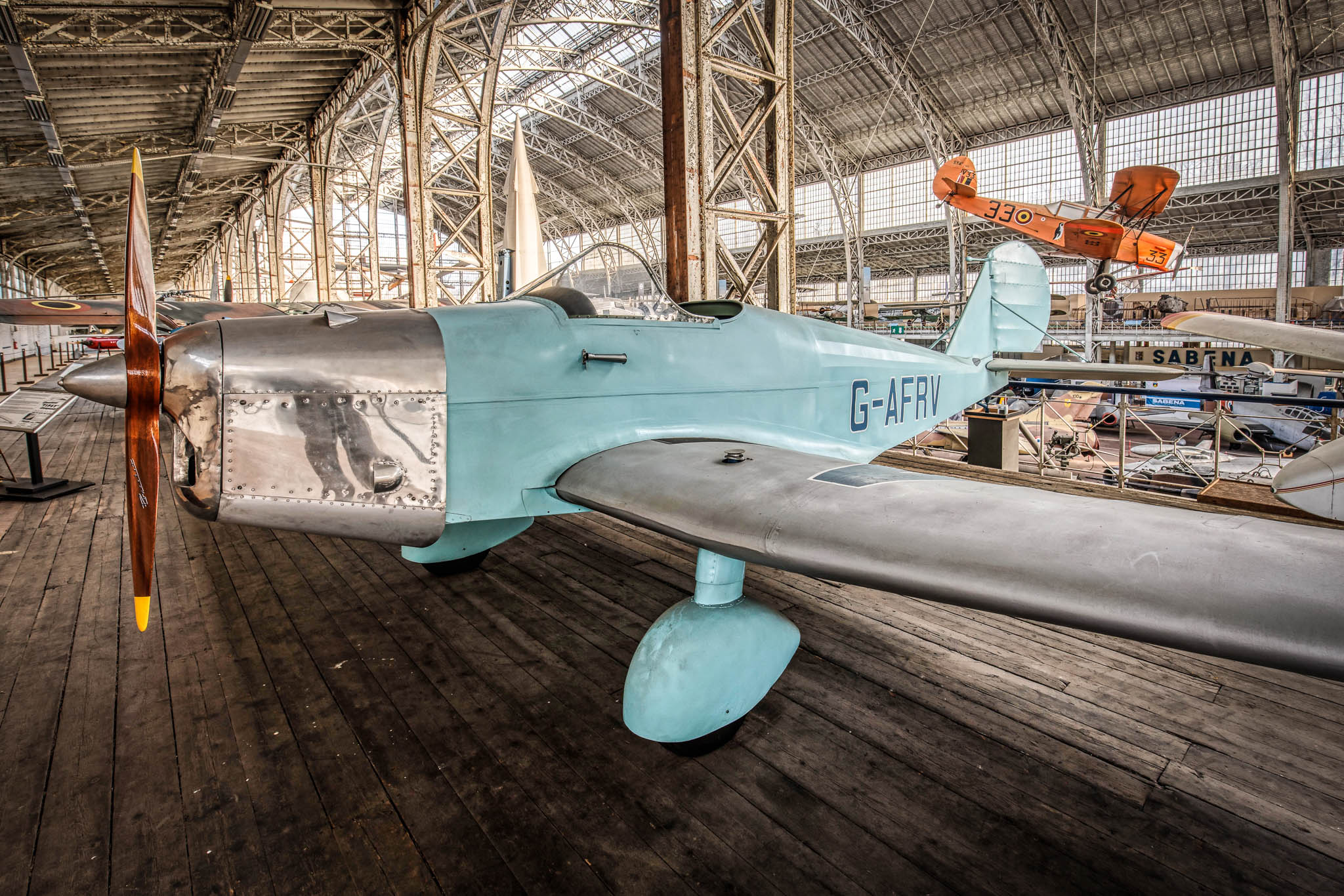 |
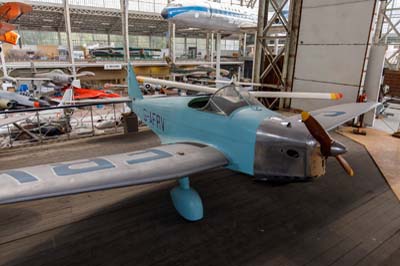 |
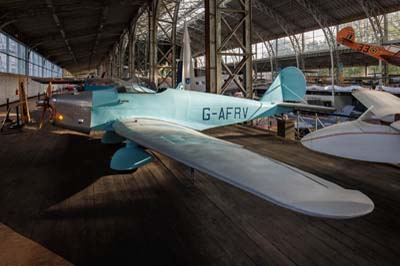 |
Left to right:
Tipsy Trainer 1 (G-AFRV) Designed by Ernest Oscar Tips a Belgian who formed Société Anonyme Belge Avions Fairey at Gosselies, Belgium in 1931 and also Avions Tipsy in 1935. The first Tipsy flew in 1933 followed by the Tipsy Junior in 1946 and Tipsy Nipper in 1957. G-AFRV has been under restoration since 2005, following a heavy crash. It required a new wing and tail and was finally completed in December 2009 when this image was taken. |
| Tipsy Trainer 1B 'Belfair' (G-AFJR '46' c/n 2). The museum restored this Tipsey B which was modified in Belfair in the 1950s. It went on display from around 2014. |
Left to right:
Tipsy S.2 (OO-ASB marked as 'OO-TIP'). Originally built by Fairey at their factory at Gosselies the S.2 was later built under licence by Tipsy Aircraft at Hanworth, UK. This aircraft was built in 1936 and registered to E. Tips in 1937 as OO-ASB. It was immediately sold in the UK as G-AFVH. This example arrived at the museum in 1966. |
| SAI KZ III (OO-MAA c/n 72). Scandinavian Aero Industry (SAI) built eleven KZ types from the KZ I to KZ X between 1937 and 1953 in Denmark. 64 KZ IIIs were built, the prototype flying in 1944. The example on display was first registered in Belgium in 1946 and was flying until 1971. Following its donation to the Museum it was dismantled and stored. In 1998 it was reassembled and put on display. As photographed in 1982. |
| Percival Gull Four II (G-ACGR). This aircraft was ordered by Sir Philip Sassoon, then Under Secretary of State for Air in the United Kingdom. In 1933 and 1934, it took part in the Kings Cup air races. However on a flight across to Europe it was written off in a forced landing in a river in Belgium and was consequently taken off the British aircraft register. Amazingly it was re-discovered by E. De Deurwaerder in 1973, wrecked in a barn near Nieuport, Belgium. Two years later he donated it to the Museum. |
| Morane-Saulnier MS.315 (F-BCNT c/n 350 unmarked ). SA des Aéroplanes Morane-Saulnier was established in 1911 by Raymond Saulnier and the Morane Brothers. Following on from their first parasol-wing aircraft the MS.230, which was flown first in February 1929, the MS.315 first flew in 1932. Designed as fighters they quickly ended up as trainers due to their lack of basic speed. Once they were disposed of by the military they became popular with civilian flying clubs. |
| Morane-Saulnier MS.230 (F-BEJO c/n 403 or 1066 it is unmarked). |
| Fairchild UC-61K Forwarder/Argus III (OO-LUT and marked as 43-14987 c/n 951). The civil version the Fairchild 24 Argus first flew in 1932. During the World War Two the USAAF ordered a utility transport and communications version of the Argus, known as the UC-61 Forwarder. The Museum's Argus was originally USAAF UC-61K (43-14987) and is displayed as such. Following its military career it was registered in France as F-BAMB before moving to Belgium in 1962 as OO-LUT. It was retired in 1970. Another Argus, OO-LMV c/n 1069, was also on display at the Museum for many years from 1979. As photographed in 1982. |
| de Havilland Canada DHC-3 Otter (OO-SUD). Following on from the smaller and very successful DHC-2 Beaver, the Otter first flew in 1951. 450 aircraft were built. This aircraft was formally with US Navy. It was later used by the 'Centre National des Recherches Polaires' until its retirement in 1972. As photographed in 1982. |
| Douglas A-26B Invader (N67160 ex D-CAFY, restored with its allotted serial as 44-34765 'AN-J'). This aircraft did not serve with the USAAF, but was eventually sold on in 1946 and registered N67160. It passed through many civilian operators before being grounded in 1965 with cracks in the wing spars. It was donated to and restored by the Institute of Aviation at the University of Illinois. It was later sold in Germany where the registration D-CAFY was allocated. From 1969 it was operated from Antwerp Deurne, before being impounded due to non-payment of landing fees. I recall seeing it at Deurne parked outside in March 1973. It was finally donated to the Museum in 1976, arriving there in November 1979. It is currently under restoration, having a turret and other military equipment re-installed, including eight .50 inch guns mounted in the nose. It has been painted in USAAF markings to represent the only A-26 Squadron to serve in Belgium. As photographed in 1995. |
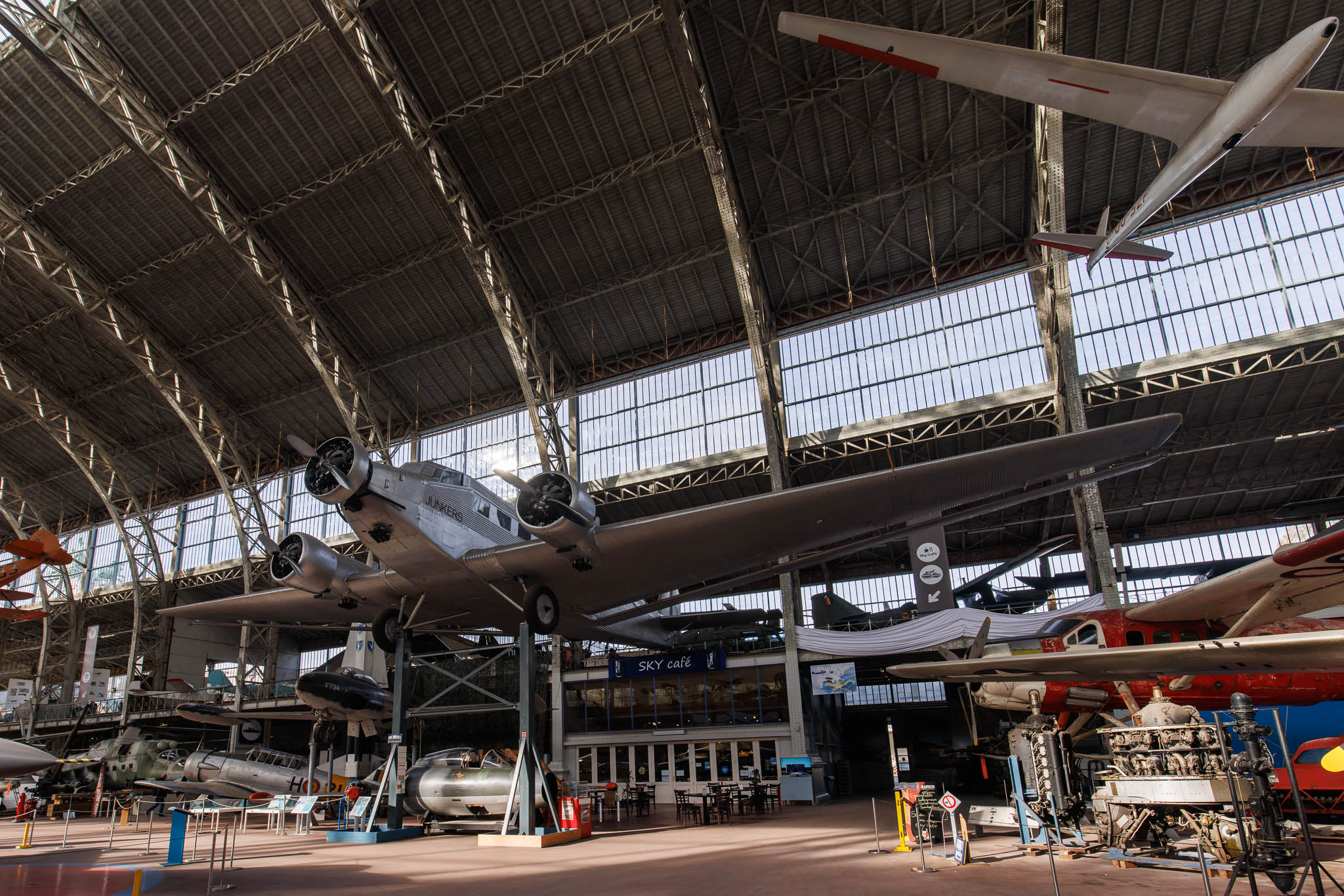 |
| Junkers Ju 52/3m (OO-AGU formally 7U+IK Luftwaffe and 6309 Portuguese Air Force). Designed in 1929, the Ju 52 first flew in 1930, by 1932 a third engine had been added (Ju 52/3m). It quickly became a very successful transport for the Luftwaffe. The Portuguese Air Force operated the Ju 52 from 1936. The Museum's aircraft was formally operated by the Portuguese Air Force, arriving from Alverca, Portugal on April 24, 1985. This Ju 52 was received in exchange for an Alouette II and a Sikorsky H-19. The BAMF started working on her in 1990 and it was finally restored as 'OO-AGU' to represent a SABENA operated aircraft from the 1930s. She was put on display in September 2001. As photographed (with 6310) at Alverca, Portugal in 1984 |
| Sud SE.210 Caravelle 6N (OO-SRA) Delivered to SABENA in 1961 and withdrawn from service in 1974. It moved to the Museum in October 1977. |
| Classic Military Aircraft but with No Connection to Belgium.... |
| Bristol 149 Bolingbroke IVT (9895 but marked as '10038 XD-A' Royal Canadian Air Force). Designed and built by Bristol the Mk.142 Bolingbroke was later renamed the Blenheim prior to its service with the RAF in 1937. It was designed as a long-range daylight bomber. Later Fairchild in Canada manufactured aircraft who retained the original Bolingbroke name. |
| de Havilland DH-115 Vampire T.11 (XH292). The Vampire first flew in 1943. The Vampire T.11 was produced from 1950 remaining in service till 1967 with the RAF. The T.11 on display, following a period of storage at Woodford, UK. was transferred to the Museum in 1973. As photographed in 1982. |
Left to right:
Mikoyan-Gurevich MiG-21F-13 'Fishbed-C' (F-2157 Indonesian Air Force, marked '77 red'). The MiG-21F-13 entered service in 1960, as a single-seat short-range day-fighter. Over the next 30 years 6,000 were built, many under license in a number of countries. The Indonesian Air Force (TNI-AU) received around 50 between 1962 and 1967. Following the fall of the President Sukarno in 1967, Russian designed aircraft were transferred to the West. The example on display is apparently on loan from the US Government and is presumed to be one of those aircraft tested secretly at Groom Lake in Nevada. It was no longer on display by December 2009, having made room for the Sea King. It was later moved to Landen for storage. As photographed in 1995.
Mikoyan-Gurevich MiG-15bis 'Fagot-B' (3911 Czech Air Force). The MiG-15bis first flew in 1949 as a single-seat fighter. The former Czech Air Force aircraft on display arrived March 6, 1989 following swap for a Meteor F.8 (EG247) which went to the Kbely museum. It was no longer on display by December 2009 later moved to Landen for storage.
Aero Let L-29R 'Delfin' (2808 Czech Air Force). The L-29 entered operational service in 1963, with production continuing until 1974 at the Aero Vodochody factory in Czechoslovakia. The Museum's aircraft (2808) was with Czech Air Force before its transfer to the Museum on December 12, 1991. It was no longer on display by December 2009. |
Left to right:
Mil Mi-24D 'Hind' (96+33 unmarked ex 528 NVA/LSK). Russian designed helicopter gunship which went into service from 1972. The German Air Force received 51 Mi-24’s from the former East German Air Force after reunification in 1990 which were mostly passed on to the Polish and Hungarian Air Forces.
Let C.11 (1317 Czech AF painted '1706'). The Yak-11 was used as a trainer by the Russian Air Force from 1947 until 1962, its design was based on the Yak-3 fighter. From 1953, 707 were licence-built by Let in Czechoslovakia as the C-11. This example was obtained by the museum in 1992 when it was exchanged for a surplus AT-6 (B-67 ex RNAF). |
Left to right:
Dassault MD.450 Ouragan 'Hurricane' (320 'UQ') of GE.314 AdlA. The Avions Marcel Dassault MD.450 Ouragan was the first mass-produced French built jet fighter, taking to the air for the first time in February 28, 1949. As photographed in 1982 and 1995.
SAAB J35A Draken 'Dragon' (35067 Royal Swedish Air Force). SAAB started work on their double-delta wing designed single seat fighter in 1949. It entered service with the Royal Swedish Air Force (RSAF) a year later and flew for the next 40 years, production ending as late as 1974. The Draken on display arrived on November 20, 1978 and wears the RSAF markings of F16 wing and is coded '34'. It was no longer on display by December 200, it was moved to storage at Landen. As photographed in 1982. |
| Mikoyan-Gurevich MiG-23BN 'Flogger' (4421 Egyptian Air Force, marked '23 red'). The Egyptian Air Force was the first foreign air force to receive the 'Flogger' from the Soviet Union, receiving eight MiG-23BNs in 1974. The example on display could be the aircraft transferred to Manching in Germany in 1986 for testing by the West, before finding it's way to a museum outside Ramstein before moving to Brussels. |
Left to right:
Dassault Mirage F1 (100 '33-LA') Manufactured by Dassault Aviation as a interceptor aircraft and ground attack aircraft and a successor to the Mirage III. It first flew in December 1966.
Aeritalia/Fiat G-91R3 (30+85 WGAF). NATO invited European aircraft manufacturers in 1953 to design a 'Light Weight Strike Fighter'. Resulting from this competition the G.91 was the most successful, with orders from the West German, Italian and Portuguese air forces. Aeritalia built 174 for the Italian and 144 for the West German air forces. A consortium of Messerschmitt, Dornier and Heinkel built 294 in West Germany. The example on display is in the colours of JBG 41 of West German Air Force and was a Strike Reconnaissance version of the 'Gina' which was operated by them from 1960 till 1981. It was transferred to Beauvechain in September 2009 and later to Landen for storage. |
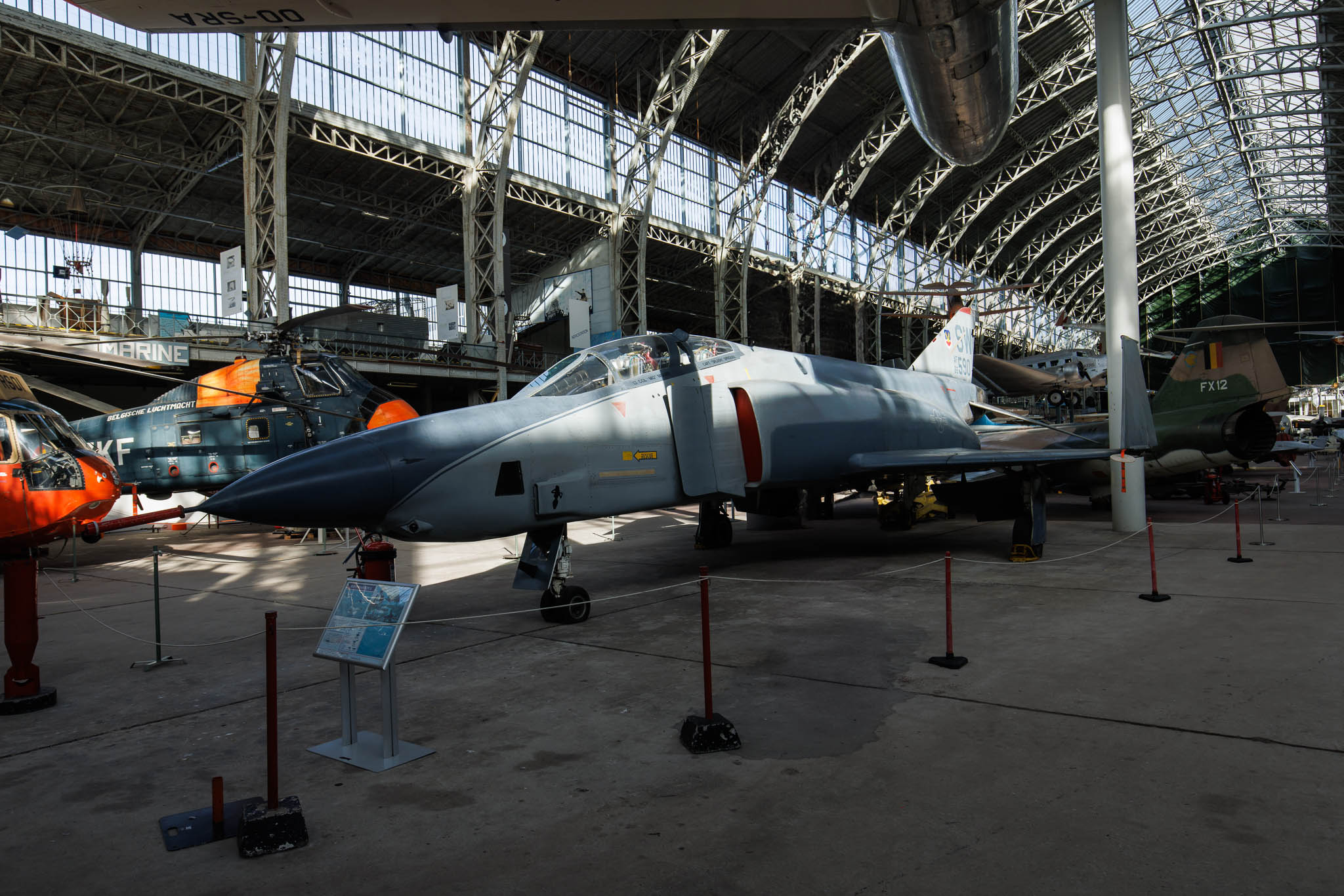 |
| McDonnell Douglas RF-4C Phantom II (68-0590 'SW'). Work on the photo-reconnaissance version of the F-4 was started in 1962, with the RF-4Cs first flight in 1964. 505 examples were produced. The Museum's aircraft wears the colours of 363rd Tactical Fighter Wing when operated from Shaw AFB, South Carolina from 1982 to 1989. As photographed in 1995. |
| Please Note: A Belgian book market (Boeken Markt), possibly on the first Saturday of each month, occupies the whole floor! |
How do you get to the Museum?
Parc du Cinquantenaire
3, Jubelpark
B-1040 Bruxelles,
Belgium
Tel: +32 (0)2 734 2157
The Museum is very easy to get to, it is situated close to the centre of Brussels. Take the train or subway to Brussels Mérode or Schuman stations.
The opening times are 09:00 to 16:00 but is closed on Mondays and National holidays (January 1, May 1, November 1 and December 25).
Additional information on the Belgian Air Force can be found on Daniel Brackx's excellent site, Belgian Aviation History Association. |
